66 Genius Garage Organization Ideas That Will Transform Your Space
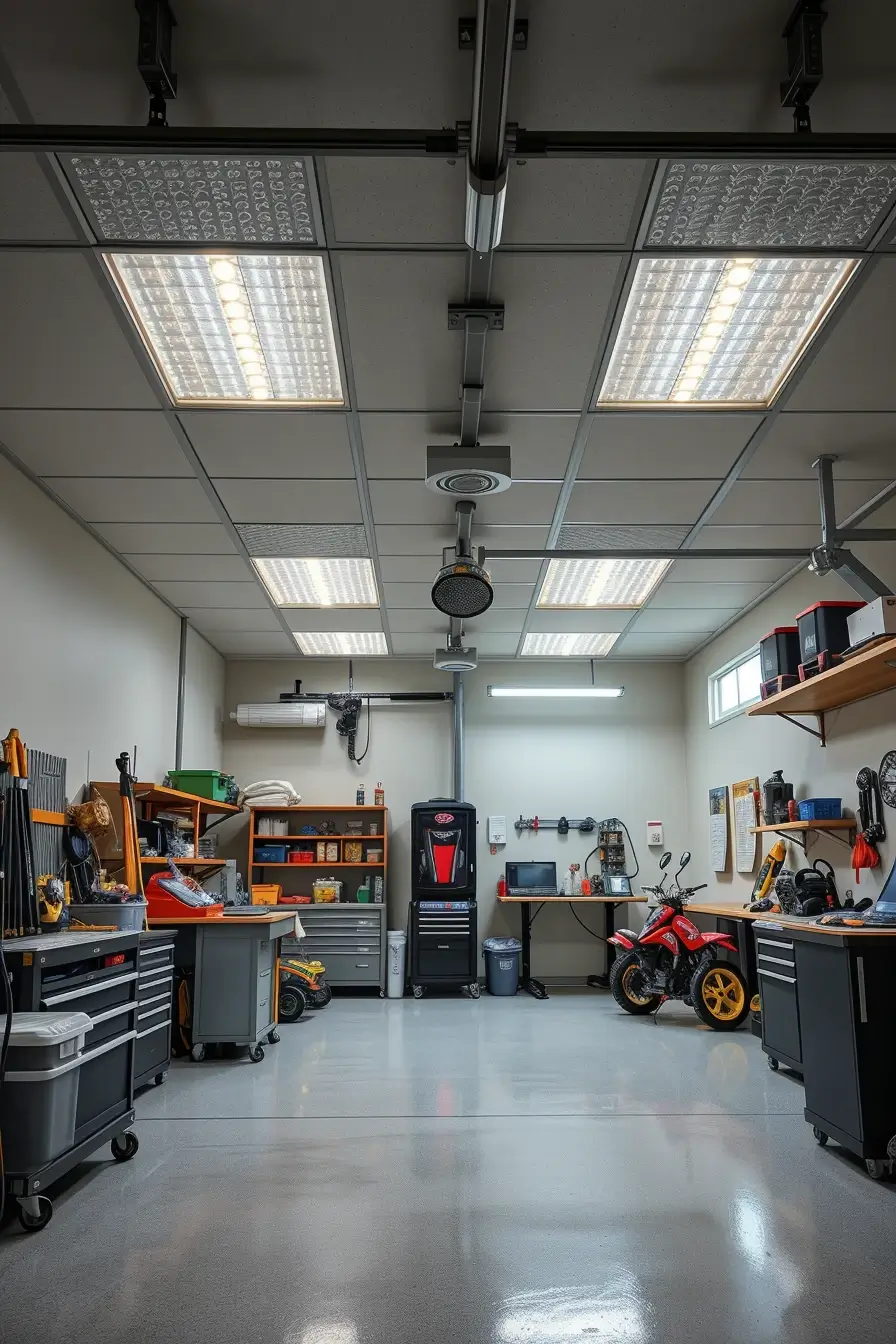
Having trouble finding space in your garage for tools, bikes, or seasonal equipment? Is that disorganized space a constant source of frustration? This article will show you some brilliant garage organization ideas that reclaim space, add function, and create a semblance of order in your life. These ideas, whether for a compact single car garage or an expansive double bay, are pragmatic, achievable, and even chic. These ideas span from ceiling racks to rolling workbenches, and make use of DIY garage storage systems, transforming your garage utterly. Let’s get started on organizing your garage like a professional.
Install Ceiling Racks to Maximize Overhead Storage
The first thing I recommend when working with a garage that has limited floor space is looking up. Ceiling racks provide an excellent way to store off-the-floor items, making use of vertical space that is often neglected. In garages with taller ceilings, these racks are perfect for stowing away large bins, seasonal decorations, and other seldom-used items. These structured ceilings systems uncluttered one’s workspace instantly freeing up valuable square footage, greatly improving a garage’s functionality.
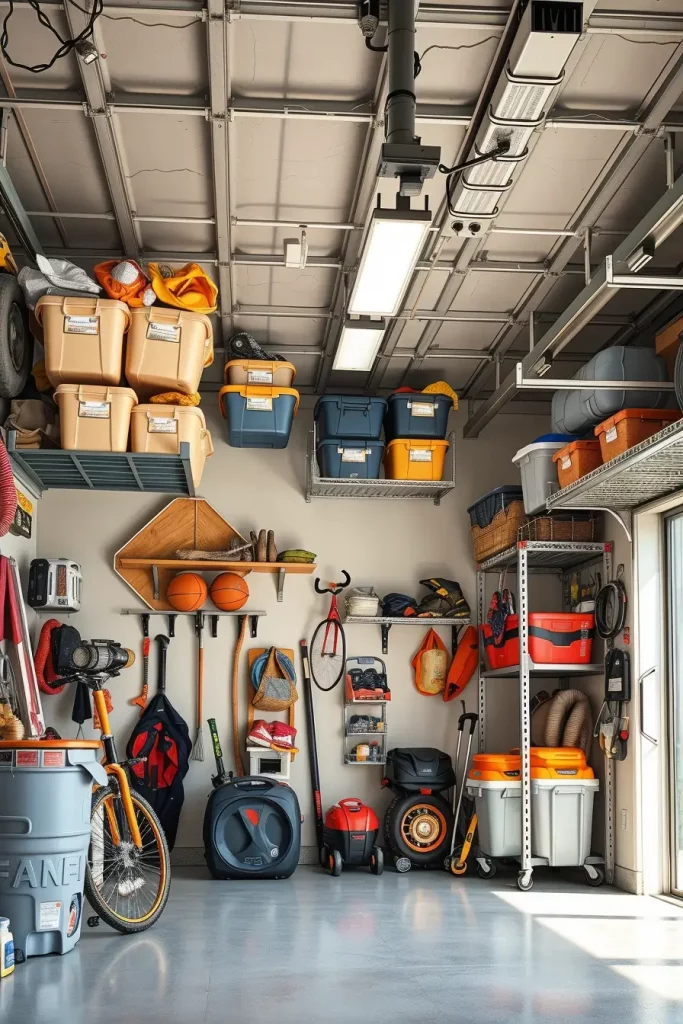
I suggest opting for heavy-duty steel racks with adjustable height settings for convenience. For safety, these should be bolted securely into the ceiling joists. Also, consider using slide-in racks with labeled clear bins that can be color-coded to aid in identification. Make sure to evenly distribute the weight across the frame to avoid overloading any one section. Some designs even incorporate pulley systems which allow for easy access without needing a ladder.
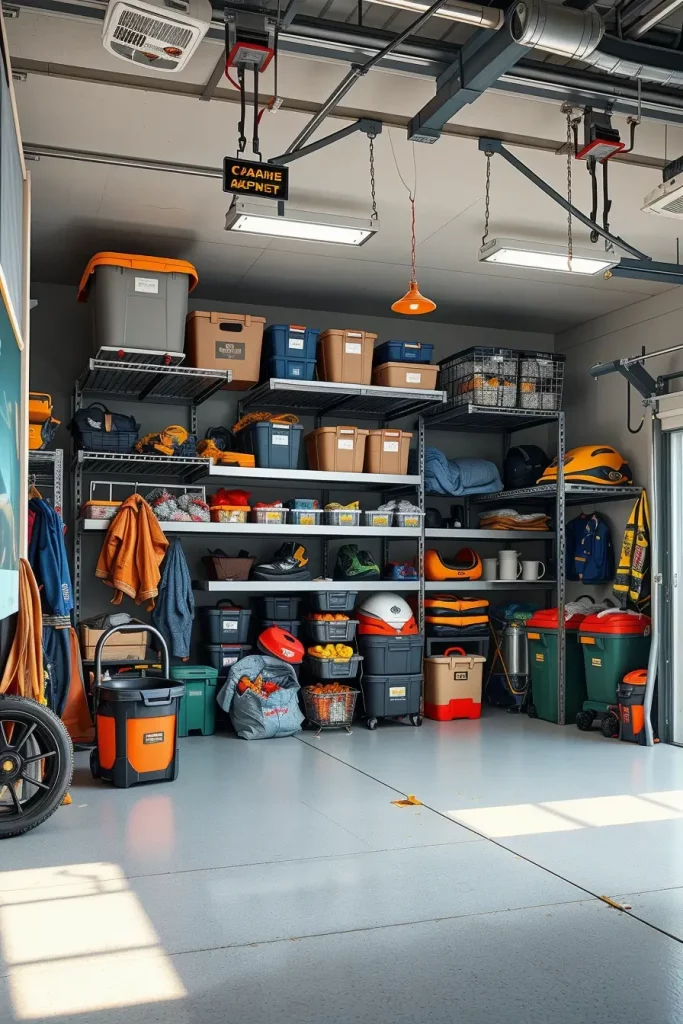
This personal setup has helped me individually store away items like camping gear, snow tires, and extra gardening supplies. This was inspired by This Old House which suggested garage ceilings as a great space to store off-season items. The system has significantly reduced the time I spent searching through cluttered garage corners while greatly improving floor space organization.
To enhance this setup, I would add a retractable platform or drop-down shelving system. This would make the setup easier to use, especially for older adults or anyone who does not want to use a step ladder often.
Create Zones For Tools, Sports, And Seasonal Gear
Having a garage can be quite useful, as it can be a tool shed, closet for sports equipment, or even a holiday storage unit. A garage can serve multiple functions at once but needs zoning as well. I recommend that you split the room into sections for tools, sports equipment, and seasonal items. Organizational zones make functionality better and clean up easier, as everything has a home. In my expert opinion, optimal zoning can maximize garage space utility.
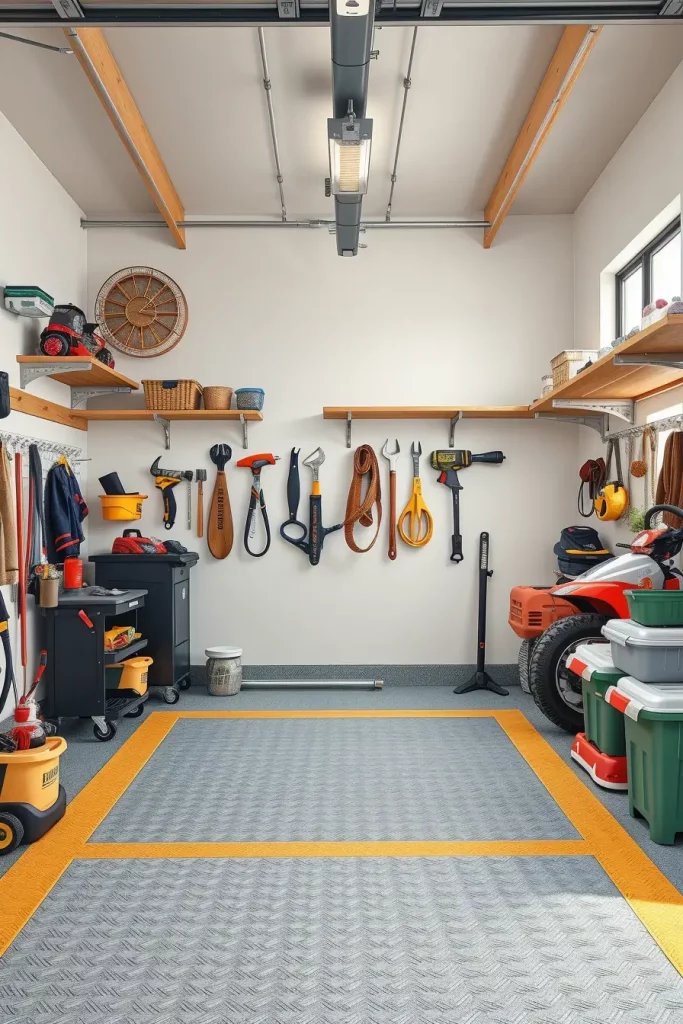
For every purpose, start by grouping parts together. For instance, set up hooks with wall-mounted bins for one sport, reserving another wall for tools equipped with pegboards and cabinets. Define zones using tape or labels. Transparent containers make great boxes for seasonal items such as lights or winter equipment. To mark the borders between zones, you can use a horizontal cabinet or long shelf.
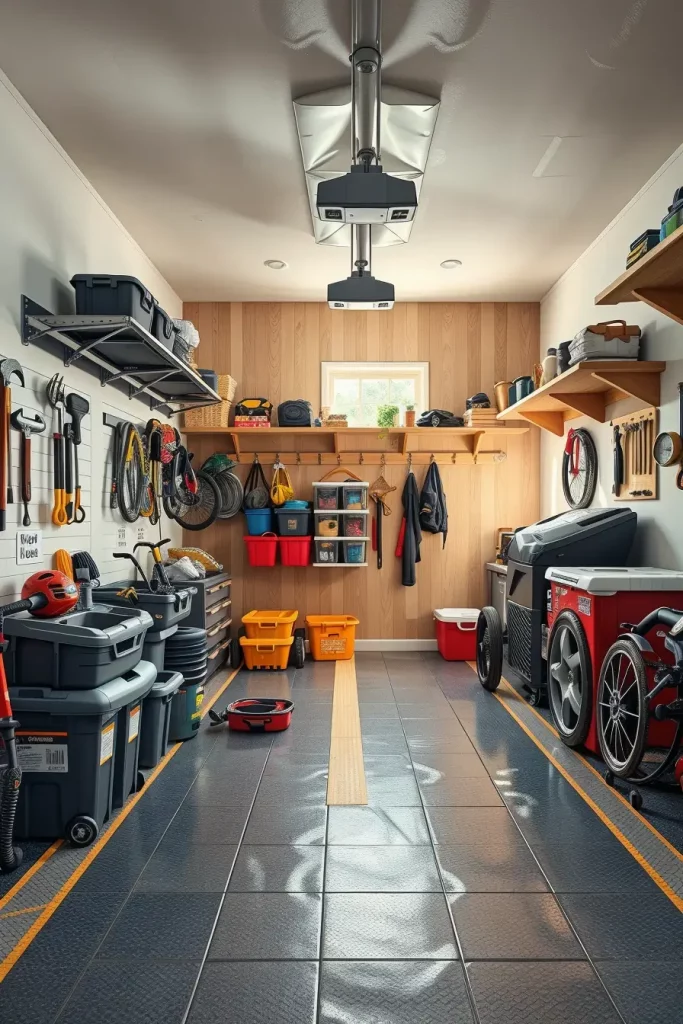
I remember aiding a client who’s a father of four. They had come to me because their kids kept losing their baseball gloves and helmets. After allocating dedicated sports zones complete with cubbies and labeled hooks, the client reported everything had been organized.
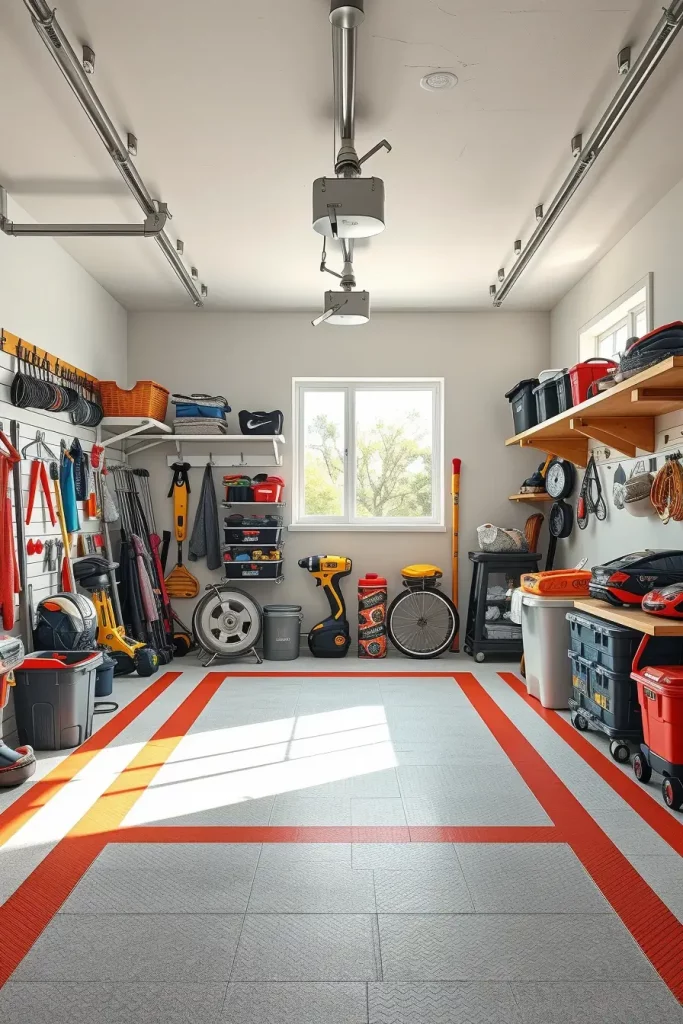
Even on school-day mornings! Vertical dividers, placed on the horizontally arranged cubbies, can make intuitive designated zones similar to those proposed by Real Simple magazine.
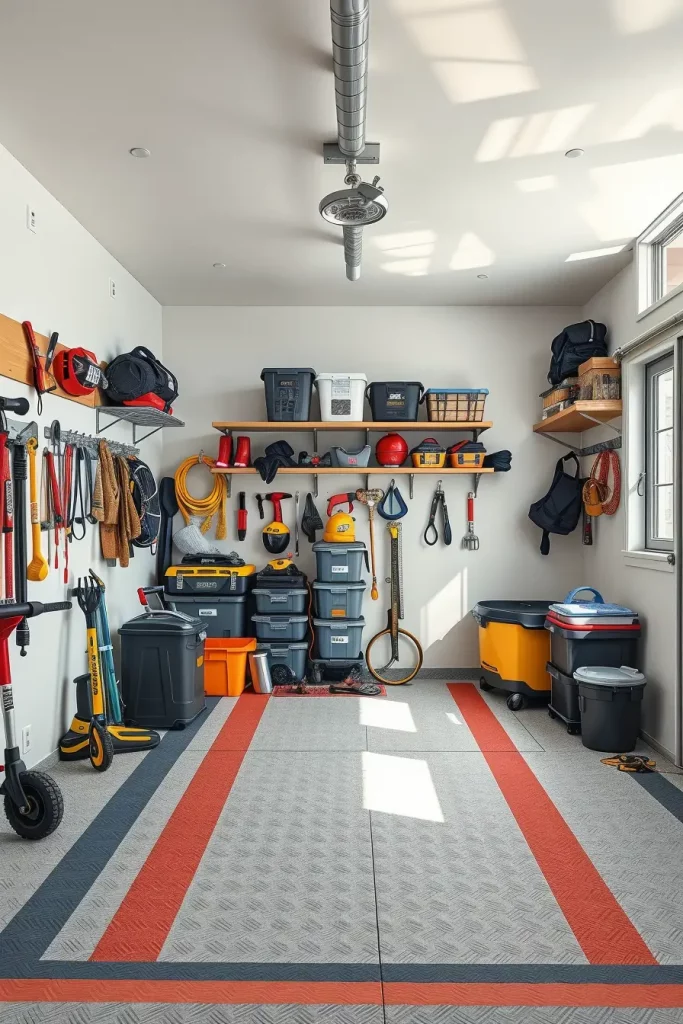
For compact spaces, I would put modular stackable bins or rolling carts between zones. This way, zones can still be adjusted for seasonal changes without the necessity of permanent alterations.
Use Pegboards On The Walls To Store Everyday Items
From where I stand, a wall-mounted pegboard is arguably the greatest addition to have in any garage. It is a pegboard organizer’s heaven – every tool can be organized and stored in sight without obscuring access. A pegboard placed on an empty wall makes an otherwise wasted space into a functional, vertical storage area which clears up counters and drawers.
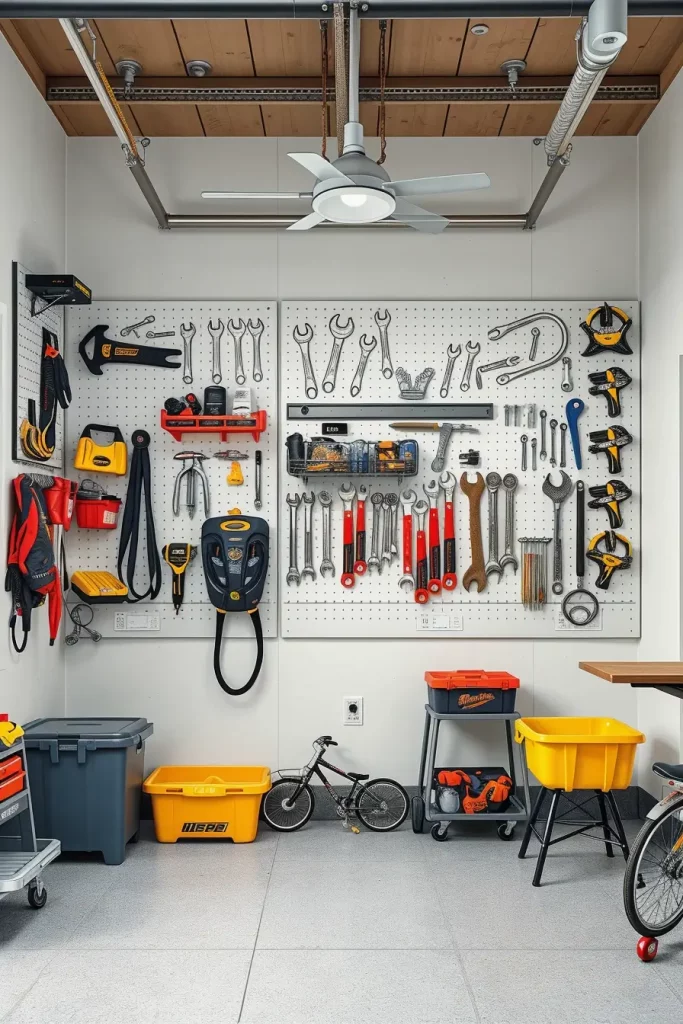
For increased strength, use a metal or high-density fiberboard pegboard and reinforce it with wooden spacers. Use shelves for mid-sized tools, and for smaller items, use hooks for hammers and screwdrivers and baskets. Tools should be arranged according to frequency of use and each section should be labeled. Even better, these systems can also include lighting panels and magnetic strips.
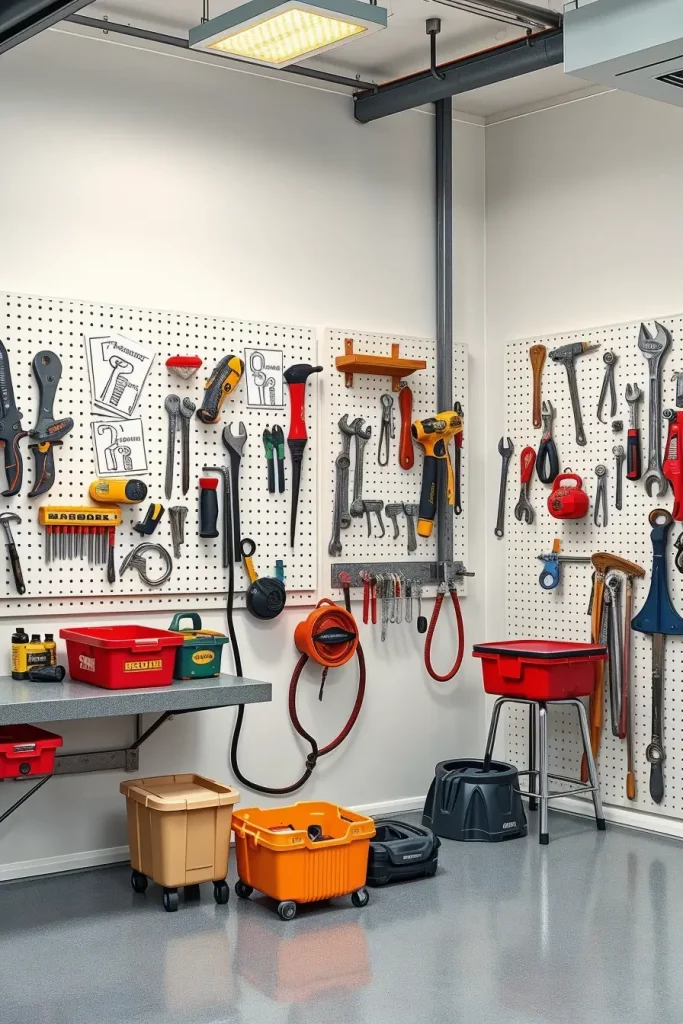
After trying this for the first time on my workshop, I was amazed by the amount of work I got done due to the raised productivity. Having everything visibly organized greatly reduces the time and stress associated with searching for items. A tip I learned from Bob Vila’s DIY Blog that I highly suggest is outlining tools with marker on the pegboard so they always return to the correct position after being used.
One additional suggestion I would make here is to add a sliding pegboard panel to increase storage without taking up additional wall space. This proposal is excellent for small garages.
Employ Rolling Workbenches For Optimized Flexibility
Mobility has one of the greatest benefits for garage design, which is provided by rolling workbenches. If you’re working on a woodworking project or a car repair, counter space might be a challenge – a wheeled bench can follow you anywhere. This is something I suggest for garages that also serve as workspaces; unrestricted arrangement options greatly enhance efficiency and order.
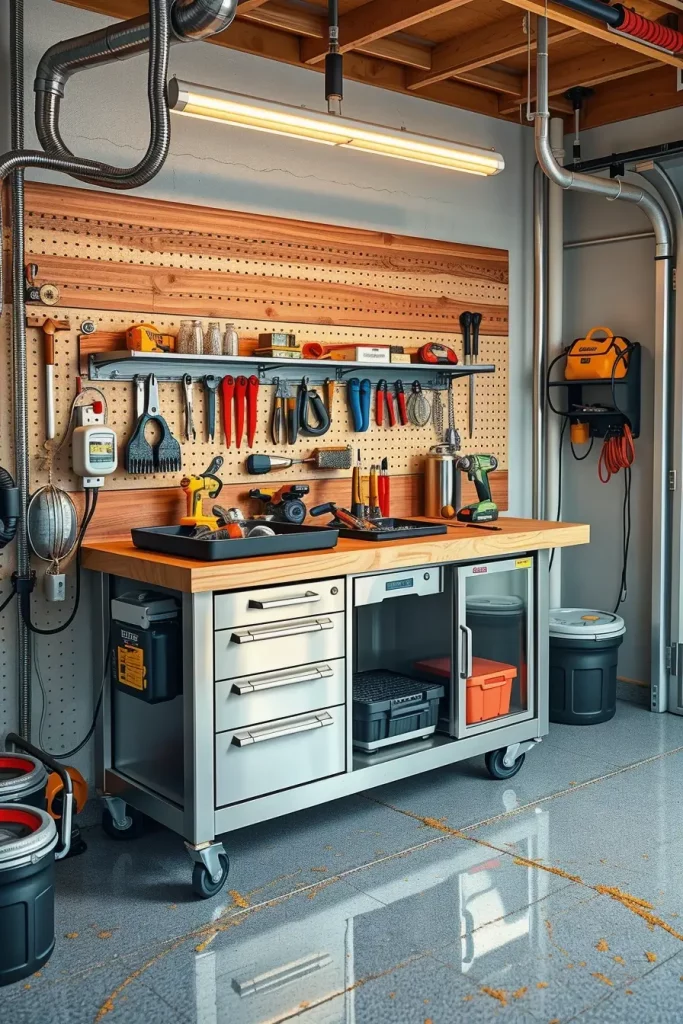
Collect a heavy-duty workbench with locked casters, lower shelves, and drawers. When it comes to the work surface, choose between wood and stainless steel; the choice depends on the nature of your work. Integrate a power strip for tools and a magnetic screw/bolt holder. For tasks that require a lot of tools, a pegboard back or fold-out tray will do.
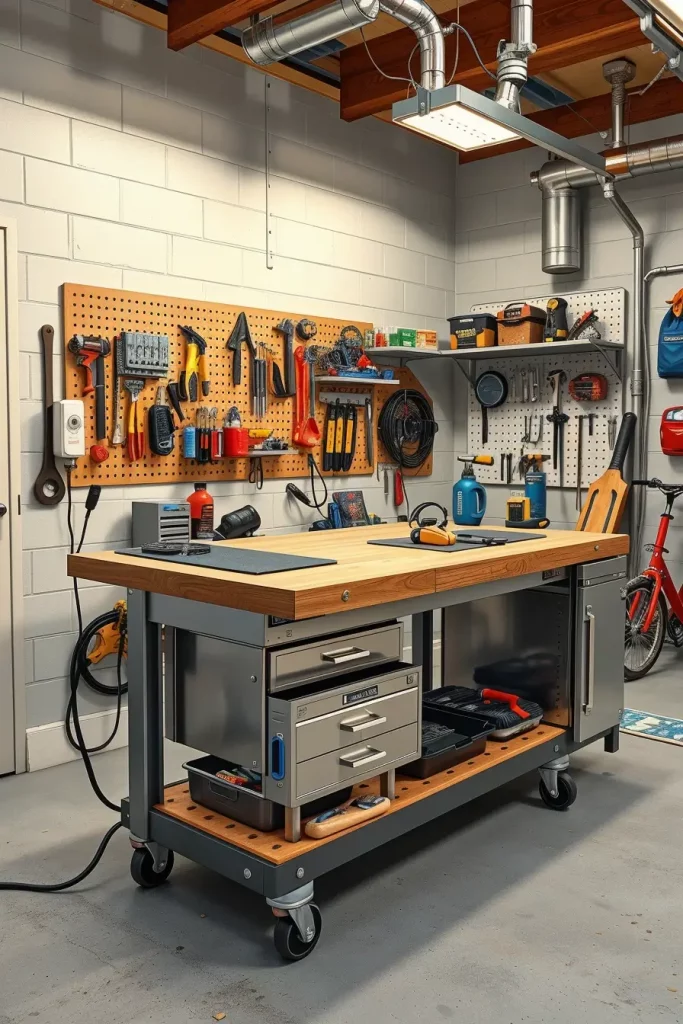
This arrangement literally changed the way I handle my weekend DIY tasks. Now, I can do outdoor work on sunny days, or I can roll the bench next to the car for oil changes. Popular Mechanic’s specialists praise mobile benches because they ‘create space out of nowhere’.
To further improve it, I will recommend fold down side tables for extra workspace to be used and clip on bins for makeshift garbage disposal units.
Vertical Bike Hanging Saves Floor Space
All bicycles are well known for being space wasters in garages, especially when they are placed leaning on the walls or lying down on the floor. Vertically hanging bikes is one of the most useful changes I have made to my garage. This action clears useful walking space while at the same time keeping bikes locked in place and easy to grab.
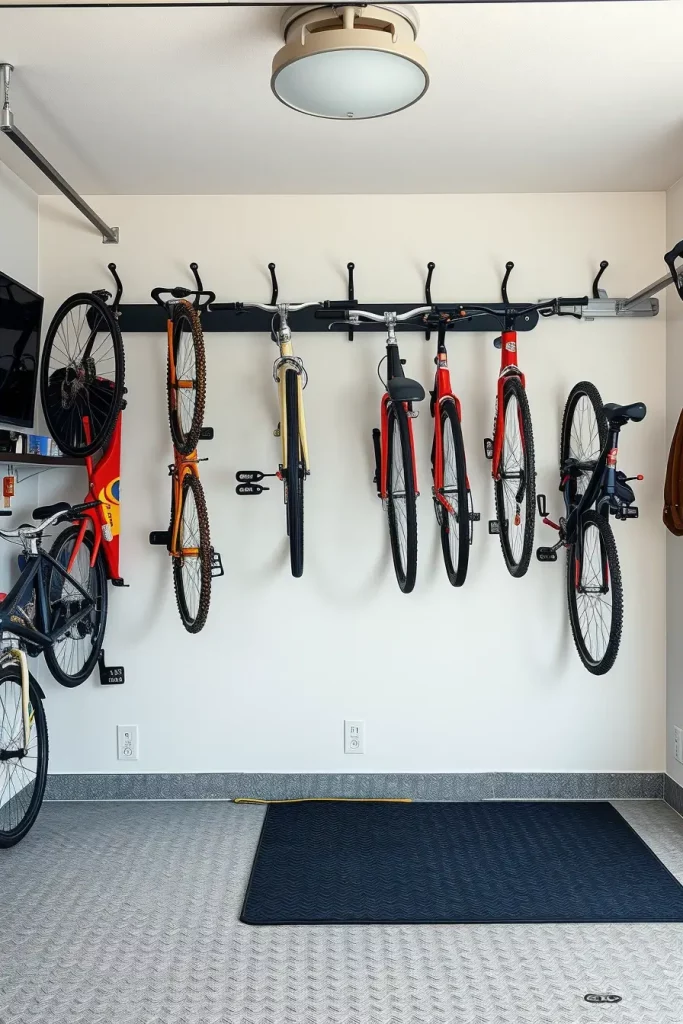
I use vertical, wall-mounted bike hooks that screw into studs to bear the weight. Each hook supports a wheel and a rear tire bumper rests against the wall. For a more sophisticated solution you may also buy pulley-type ceiling hangers. Do make sure that each bike is hung lower than eye level for easy grab, especially for kids.
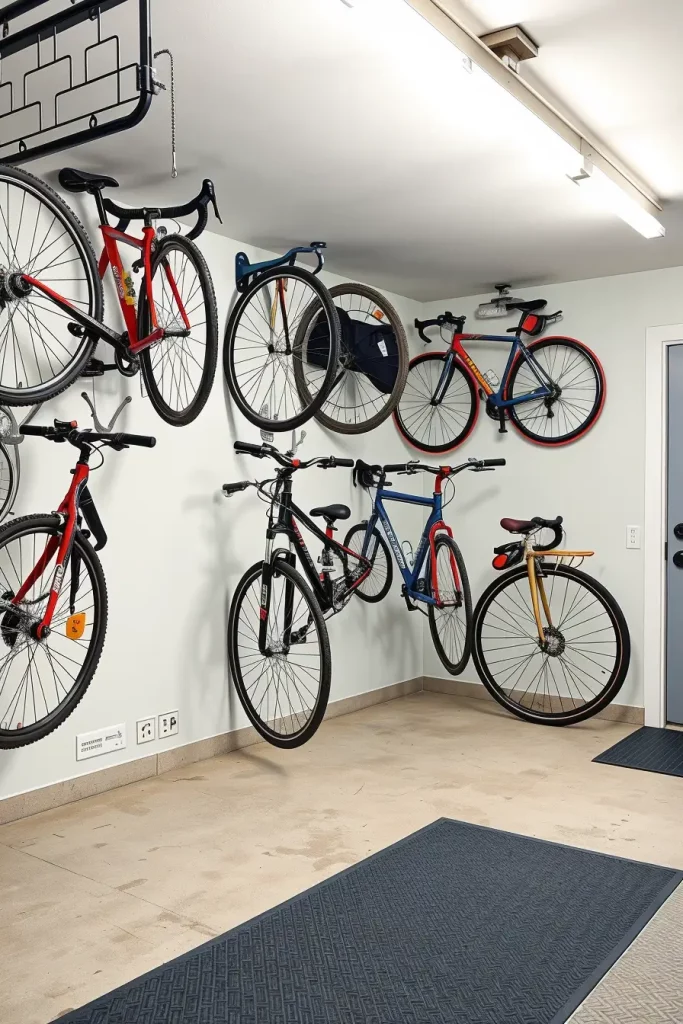
Increased floor space was a huge advantage for my family of four. As per Better Homes & Gardens, vertical storage is safer as well. In my instance, freeing up space meant I could store additional bins underneath.
To improve the system I would add a designated mat beneath each hook. This would catch any dirt or debris from the tires. As a result, the garage would remain clean, with little effort required.
Add Magnetic Strips For Small Metal Tools
Magnetic strips are a requirement for garages full of wrenches, pliers, and drill bits. They serve an essential purpose in providing a sleek, efficient way to arrange small metal tools. Keeping small tools available and within easy reach is especially important. That’s why I prefer keeping them at eye level next to the workbench.
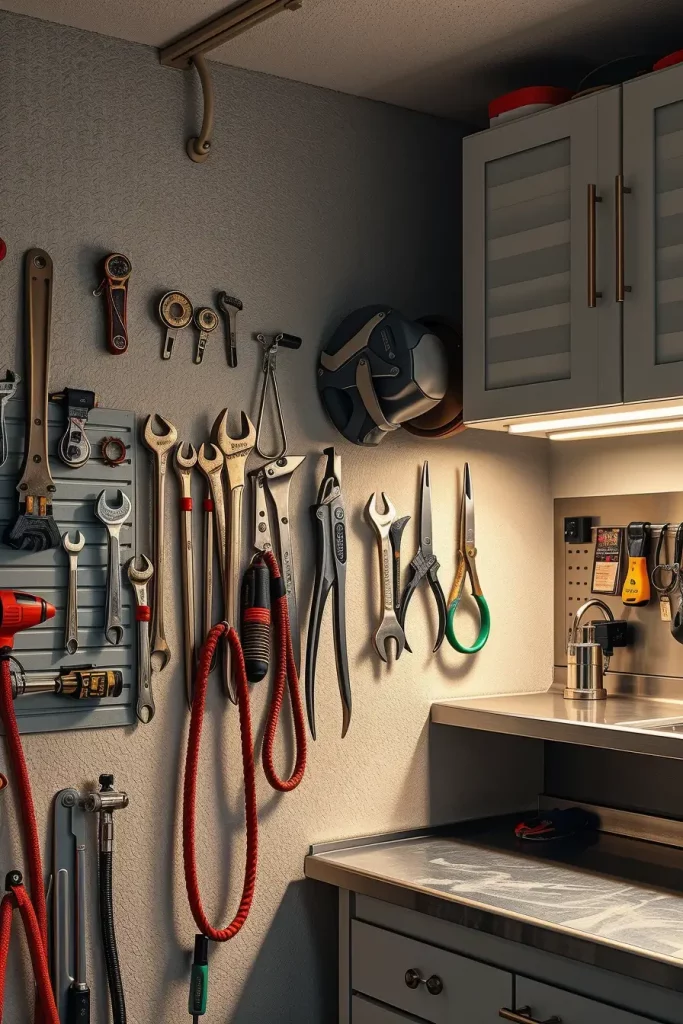
Along a wood or tile backsplash, one or more magnetic strips should be placed. Each tool should be spaced adequately to avoid crowding. To enhance this solution, a labeled board placed directly underneath can be used to quickly identify each item.
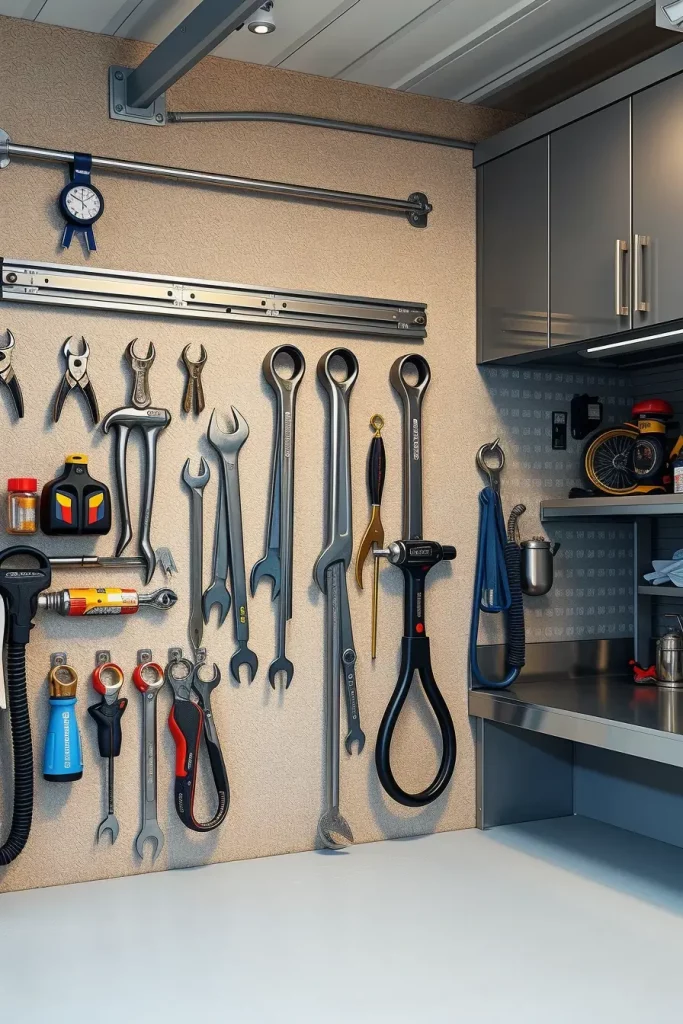
After reading about it in Family Handyman, I implemented it in my garage and it has changed the way I work. Instead of searching through drawers for a missing wrench, everything is clearly labeled. This is an absolute must for garages where every inch matters but access to tools is non negotiable.
If I were to take this further, I’d place LED lights above the strips for enhanced visibility and place a second strip below the first one, so that light weight tools such as measuring tape or scissors could be placed there.
Chalkboard Labels or Vinyl Tags for Everything
A busy garage is the same as a chaotic one, which is why I took the time to add proper labeling. Tags and bins have outlines which makes identifying their contents much simpler. This label solution has helped me personally focus on keeping things organized for an extended period of time.

Chalkboard labels work best for myself as temporary, seasonal gear storage and vinyl labels work as permanent fixtures. Markers allow for quick changes as only a few words need to be written whereas permanent looks better. Tool and storage boxes, cabinet doors, and chest drawers can be labeled. Items can be color coded based on their type for effective and simple identifying.
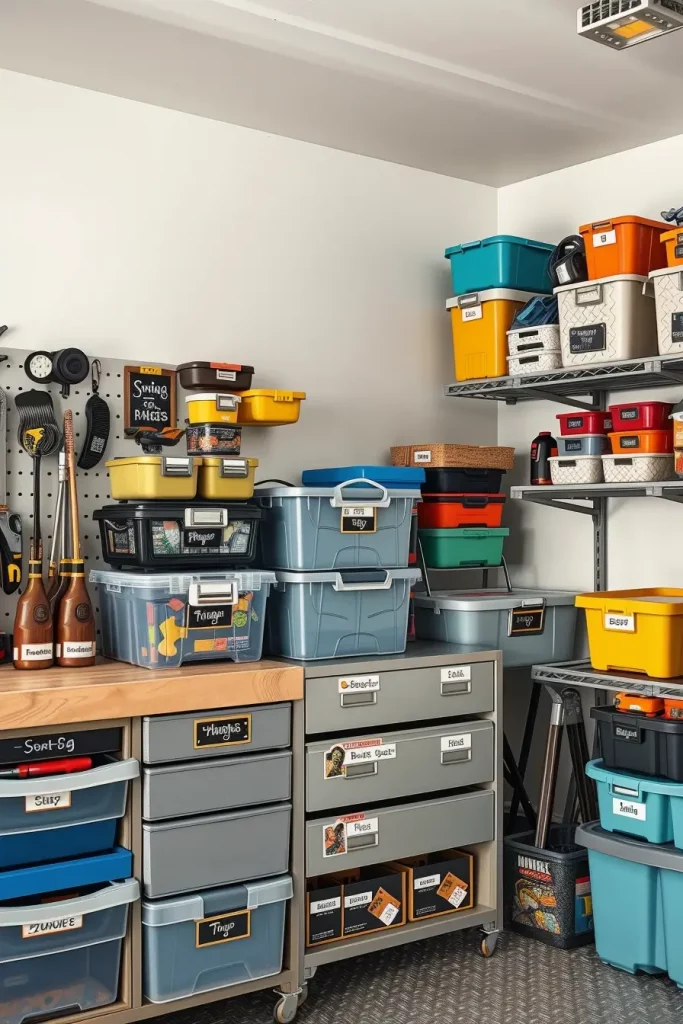
In my experience, this dramatically speeds up retrieval times – particularly when trying to obtain a battery or lightbulb while performing a task. The Spruce and other professional organizers recommend labeling to streamline visual clutter and enhance productivity.
As an additional improvement for this concept, I would recommend scanning QR codes to larger bins that link to a digital inventory, particularly for large garages with many compartments.
Stackable Clear Bins Are Perfect For The Seasonal Storage
Strategic storage of seasonal items is often neglected in a garage organization system. For ease of access and visibility, I recommend stackable clear bins. These containers keep everything from holiday decor and camping supplies to winter gear free from dust and neatly organized. Its aesthetic appeal aside, a wall of stacked bins saves considerable shelf space.
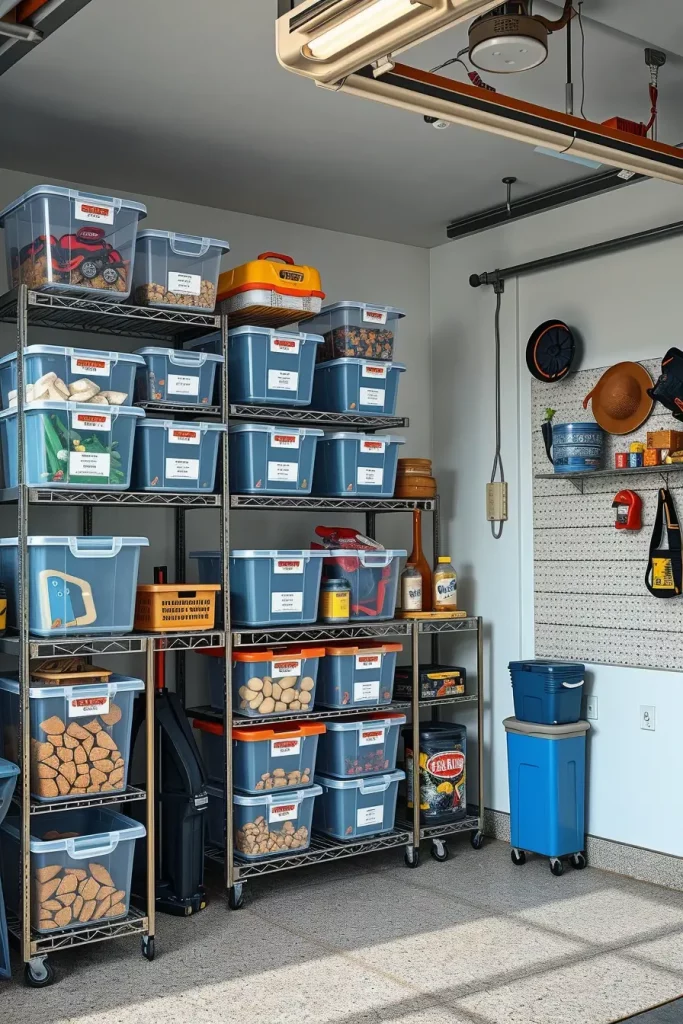
I prefer using clear plastic bins with locking lids. My bins have uniform dimensions. Writing labels vertically helps view them from different angles. Stacking these on heavy-duty wire racks vertically saves on floor Space. Labels should be on both front and top to be visible from all angles. Transparency means you can quickly identify what’s inside without wasting time opening multiple bins.
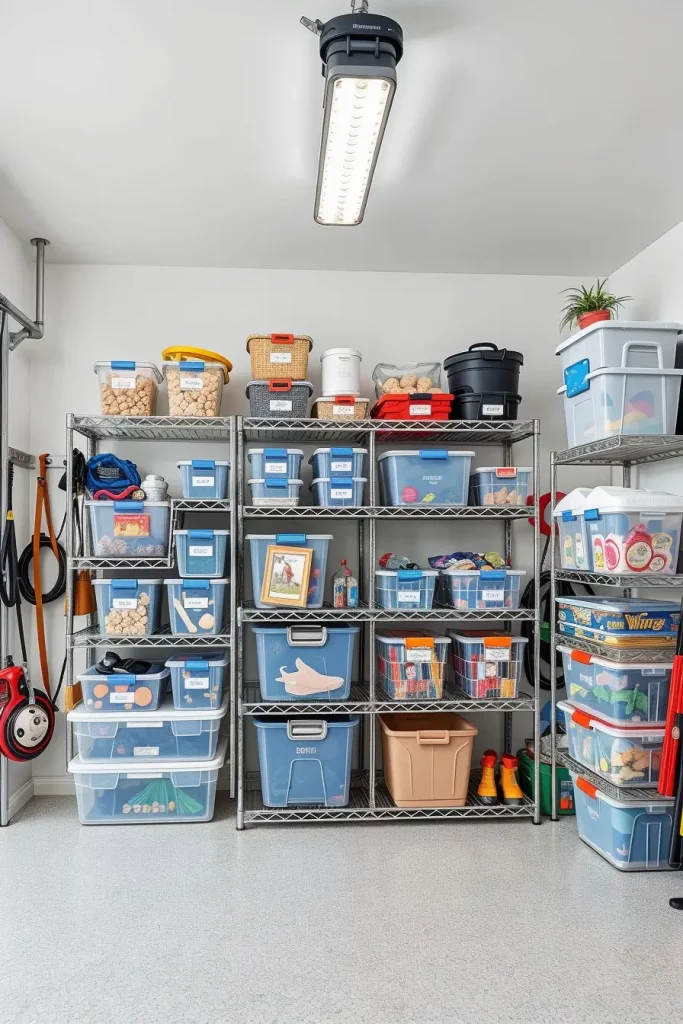
In my garage, these bins have changed how I manage storage. I seasonally rotate them, putting spring and summer gear up front while moving holiday items toward the back. The Home Edit proposes using clear bins for almost all organizing situations because they enhance and simplify organizational systems.
To improve this particular stacking system, I would recommend incorporating a rolling dolly platform or track system to the bottom of the stack to make them mobile. This is particularly useful in garages that are tight on space and require frequent rearranging.
Transform Kitchen Cabinets Into Garage Shelves
One of my favorite DIY tricks is repurposing kitchen cabinets into a garage. This gives the opportunity for built-in storage without the expense of purchasing new units. Why not stick those old cabinets to the wall, and instantly gain closed storage that lacks visibility? Not to mention, it polishes up the garage which makes it look more intentional.
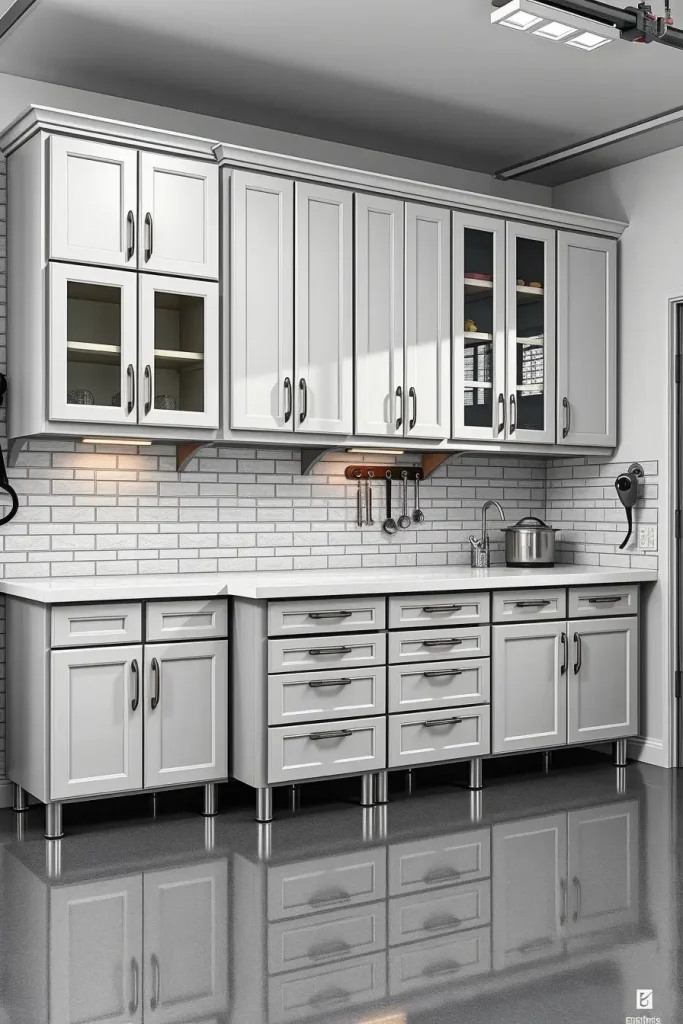
In my project, I chose the upper and base cabinets with doors and adjustable shelves. Closed doors eliminate excess clutter and keep the contents dust free. Drawers can be fitted with tool trays and the surface can be utilized for small tasks. The beauty of this solution is that it canbe painted to align any garage aesthetic.
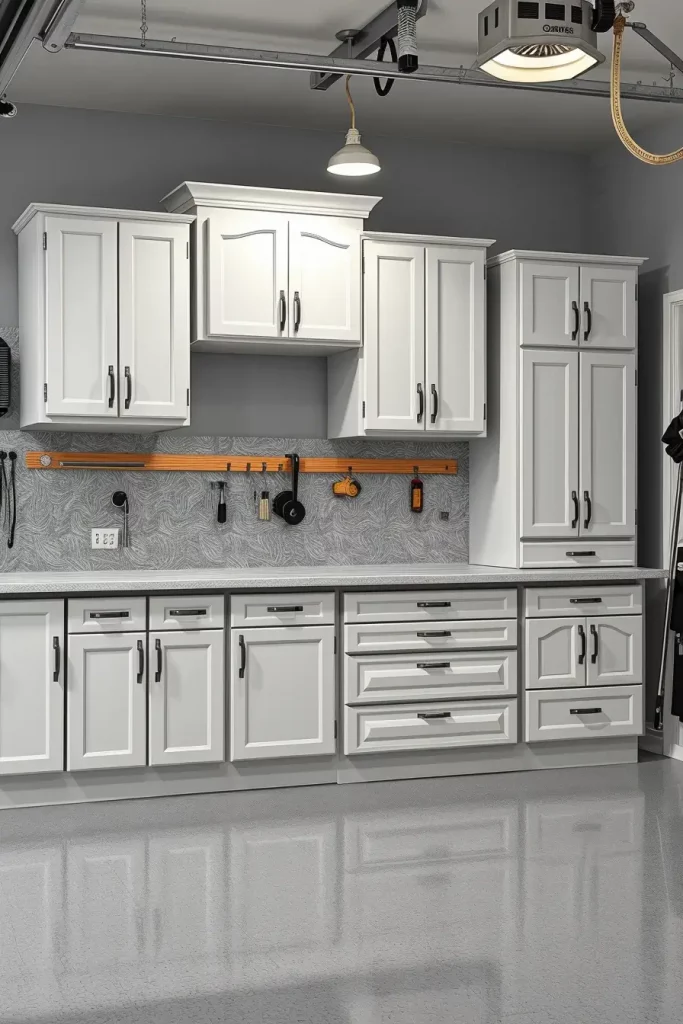
All of my cabinets were painted a matte black which blends beautifully. They gave my garage a polished finish basement feeling which I absolutely love. These cabinets helped me camouflage a myriad of items, from automotive supplies, power tools, and various pet food containers. They are all conveniently out of sight and reach.
If I were to take it further, I’d add motion sensor lights inside each compartment for improved visibility, in addition to perimeter lights outside, and cabinet locks for safety.
Create A Mudroom Zone Beside The Entrance Door
A garage that opens directly into the house is perfect for including a mudroom zone. It helps to prevent the intrusion of dirt, water, and clutter into the living area. This is something I personally recommend for parents with children or anyone who wants to minimize the amount of cleaning required for the floors.
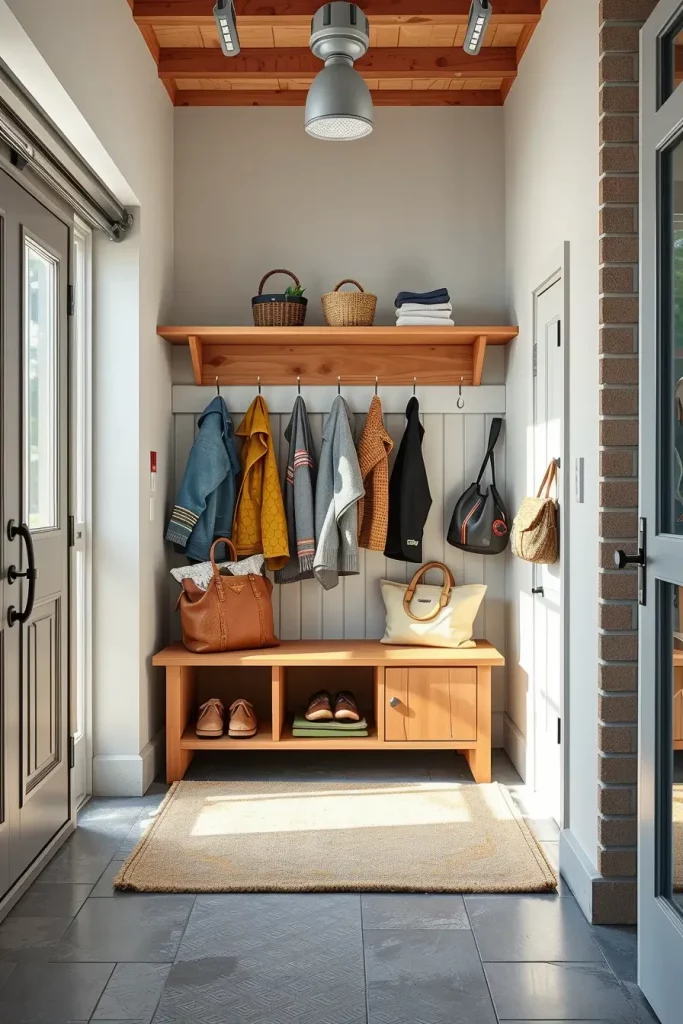
A mudroom should have a sitting area, and as such, I like to provide a built-in bench with cubbies beneath it for shoes, and a slatwall to hold jackets, bags, and umbrellas. I also like to add a washable rug along with a shelf filled with glove and scarf bins I am happy to place together. The products must be of low-maintenance—waterproof mats and scuff proof wall paint, for example.
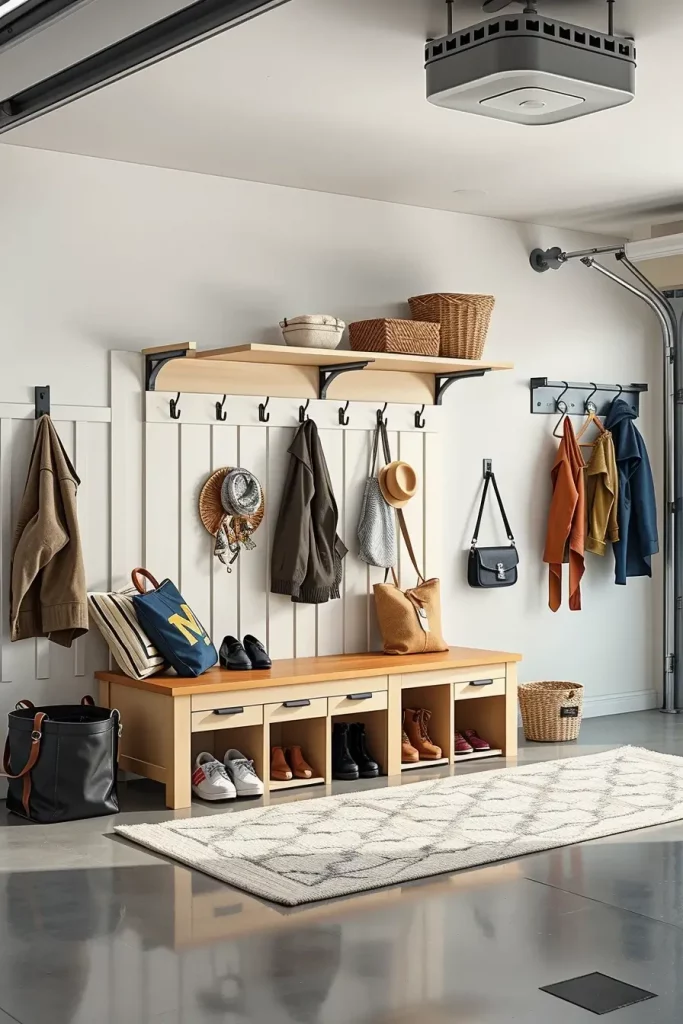
I worked on a design like this for a client recently who has two dogs and three children. Besides improving their cleaning routine, it also added usefulness to what was essentially wasted space. As stated by Apartment Therapy, even a mini mudroom allows for a huge improvement in effectiveness over the course of a day.
One change I might suggest is implementing a narrow shoe dryer or a heated mat for use in colder regions. It adds to the comfort and keeps the area dry and slip resistant.
Incorporate Slatwall Styles For Flexible Custom Hanger Options
Slatwall panels are a versatile and effective garage wall system for every user currently available on the market. I usually recommend them to clients looking for both aesthetic appeal and adequate utility in their garage. Moveable hooks, baskets, bins, and shelves are made possible by these panels because of changing storage requirements.
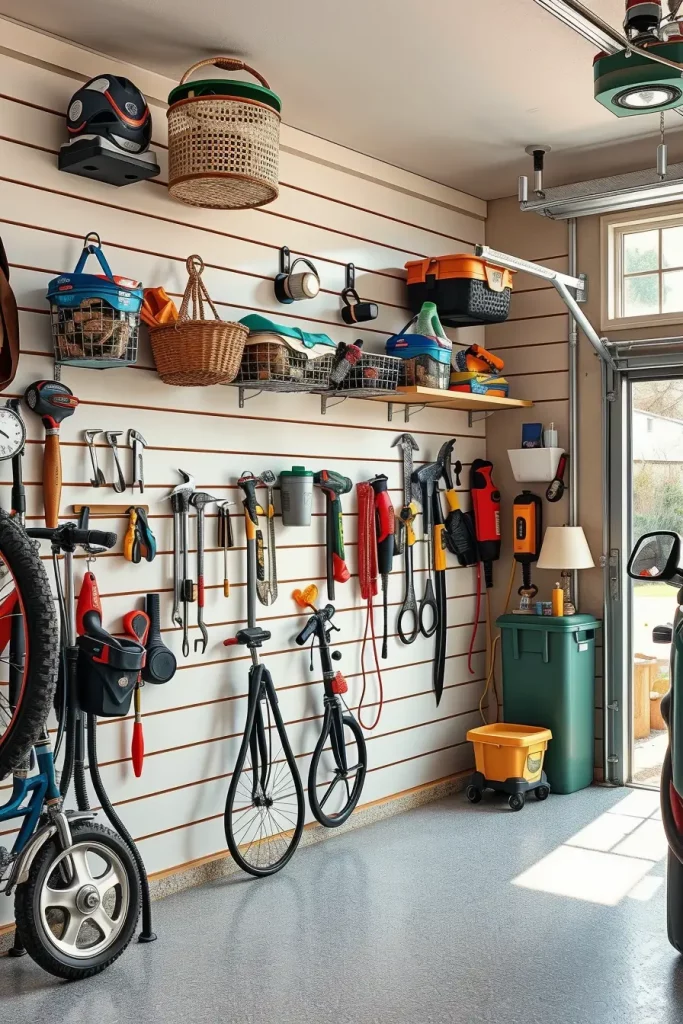
I work with PVC or composite slatwall panels which I mount on a single wall like behind a workbench or the side of the garage. The accessories click onto the panels and support a wide range of items including gardening tools, helmets, and extension cords. The modular nature of this system is what makes it so effective.
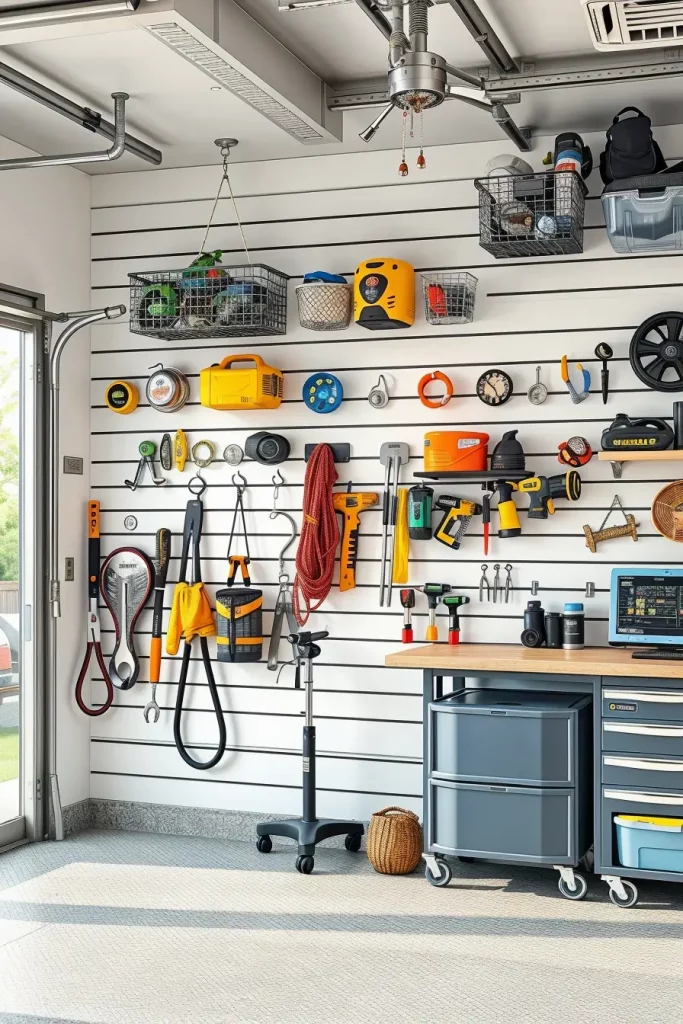
After incorporating these in my own garage, I was able to seasonally adapt the space and easily store oddly shaped items like rakes and leaf blowers. Slatwalls are highly recommended by This Old House for their strength and flexible appeal while still providing some aesthetic value.
To improve the design, I would suggest incorporating lighting or backlit strips for easier visibility, particularly in winter months or dark garages.
Create A Garden Tool Corner With Hooks And Hoses
Every garage needs a zone for organizing long-handled garden tools and hoses, and personally, I make sure to carve out a garden tool corner specifically for this. Rather than having tools leaning against walls and hoses piled up, I use hooks along with hose reels, which helps give everything a tidy place.
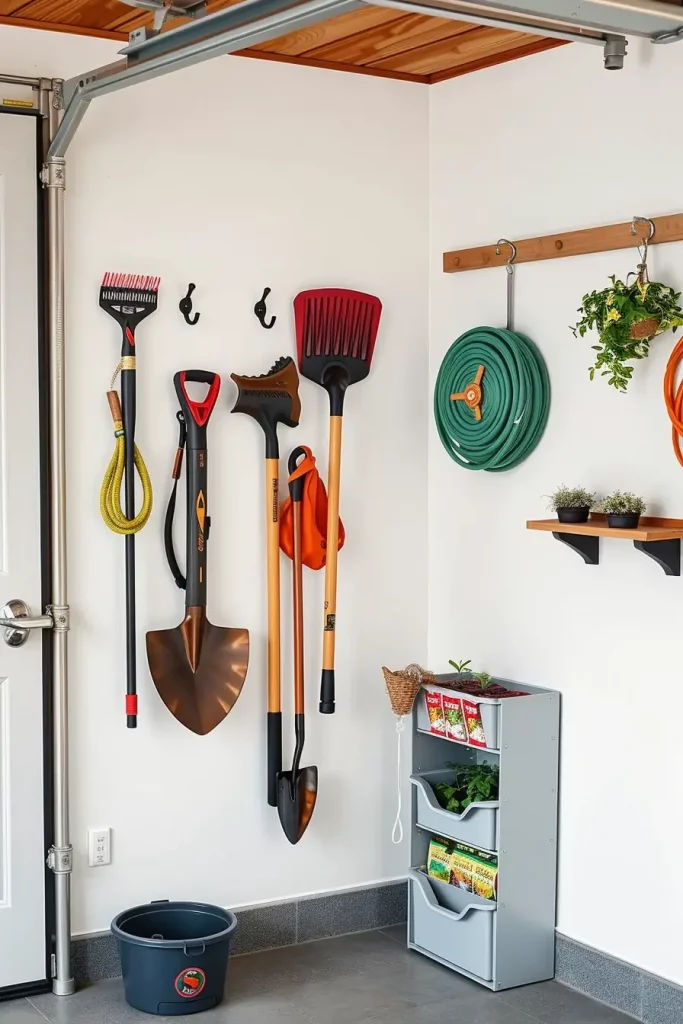
I recommend using heavy duty steel hooks arranged by height for shovels, rakes, and brooms. For hoses, wall-mounted retractable reels are a great choice, as they help avoid kinks and tangles. Additionally, this area can include vertical shelving to hold plant food, gloves, or watering cans.
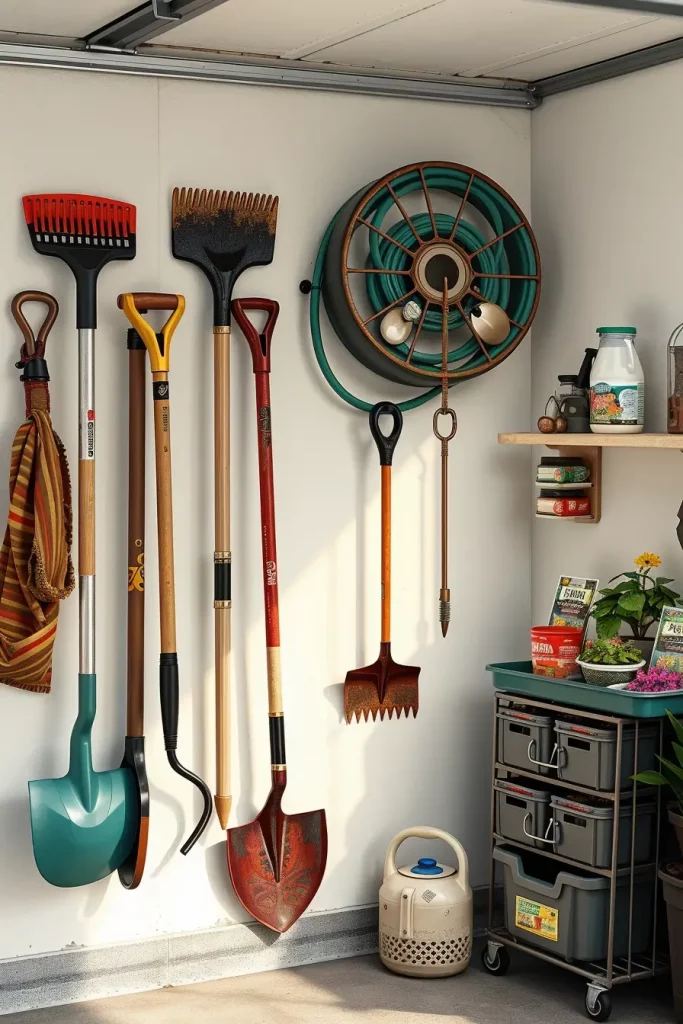
I personally reorganized a cluttered corner in my home, turning it into a clean, functional space. I even included a narrow shelf with labeled plastic drawers for seed packets and hand tools. As per Martha Stewart Living, dedicating even a small space for gardening helps provide accessibility while encouraging frequent maintenance.
For maximum efficiency, I would install a calendar or board for planning and maintenance reminders as well as a wall-mounted organizer for pruning shears and snips.
Using Tension Rods To Hang Up Spray Bottles
When a client needs cleaning supply organization tips for the garage, my go to suggestion is using tension rods to hang spray bottles. This is a simple solution that enables visibility while keeping everything tidy. Best of all, it is renter friendly!
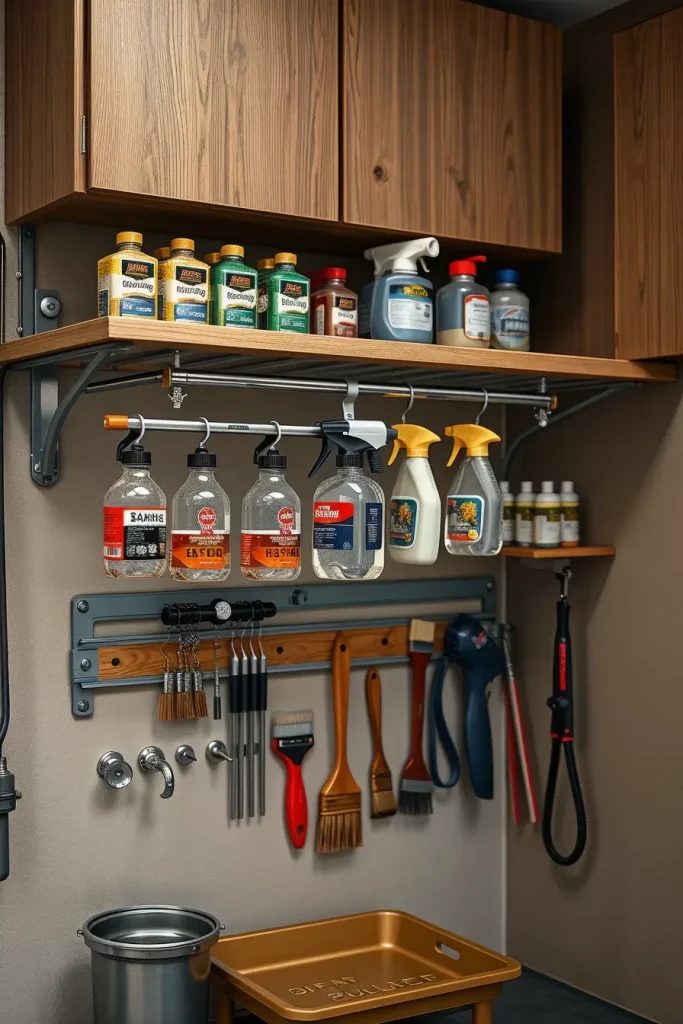
Hanging from a cabinet or open shelf, the tension rod can be installed anywhere. Just place the trigger handles over the rod and the bottles will hang straight down. The tops of the bottles will be dry while the labels can be seen. It works wonderfully for detailing car products, gardening sprays, or even household cleaners that are dirty and not deemed fit to be stored inside.

I first came across this idea on Good Housekeeping, and right away I saw the appeal of the neatness and easy access. This solution is also great for optimizing shelf space that often goes overlooked.
A detail that would make this even better would be placing a magnetic strip nearby for holding on cleaning brushes and bottle openers and a shallow pan below the rod to catch any drips that might come from the bottles.
How to Transform Unused Corners Into Storage Nooks
Garages often have wasted empty odd corners. However, with some creativity, these peculiar spaces can be utilized as functional storage nooks. I love to solve these problems using vertical racks combined with custom cabinets and corner shelves for every project.
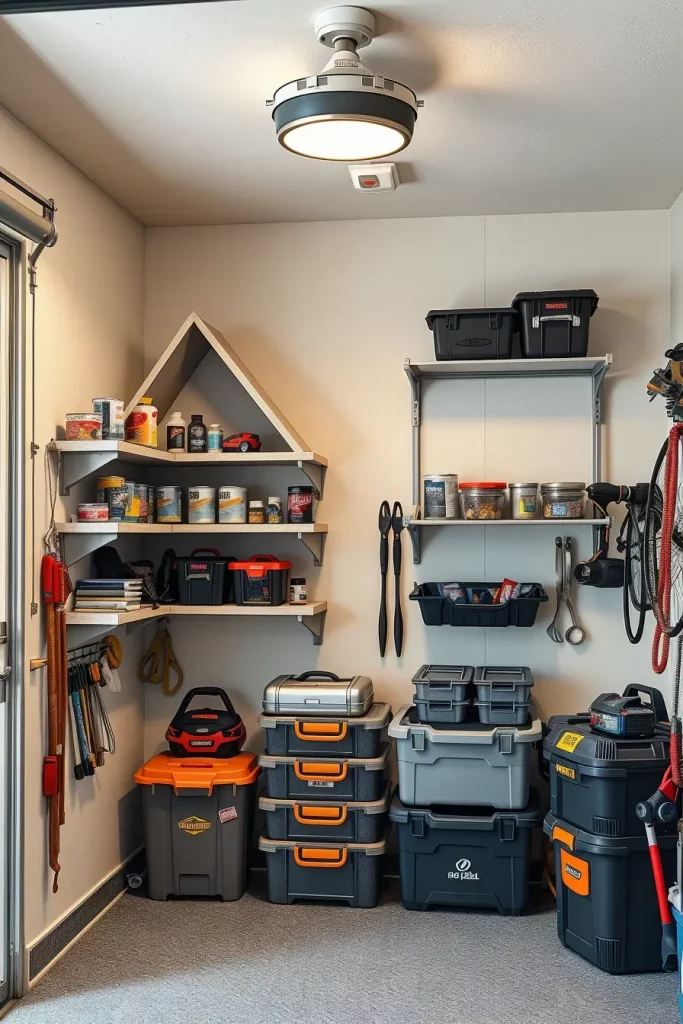
They make my life so easy. It is possible to store toolboxes, paint cans and some small appliances as well. Install corner cabinets with lazy Susans that are rotatable for ease of accessibility. These shelving units are designed to climb vertically which means that they won’t use much of the floor space.
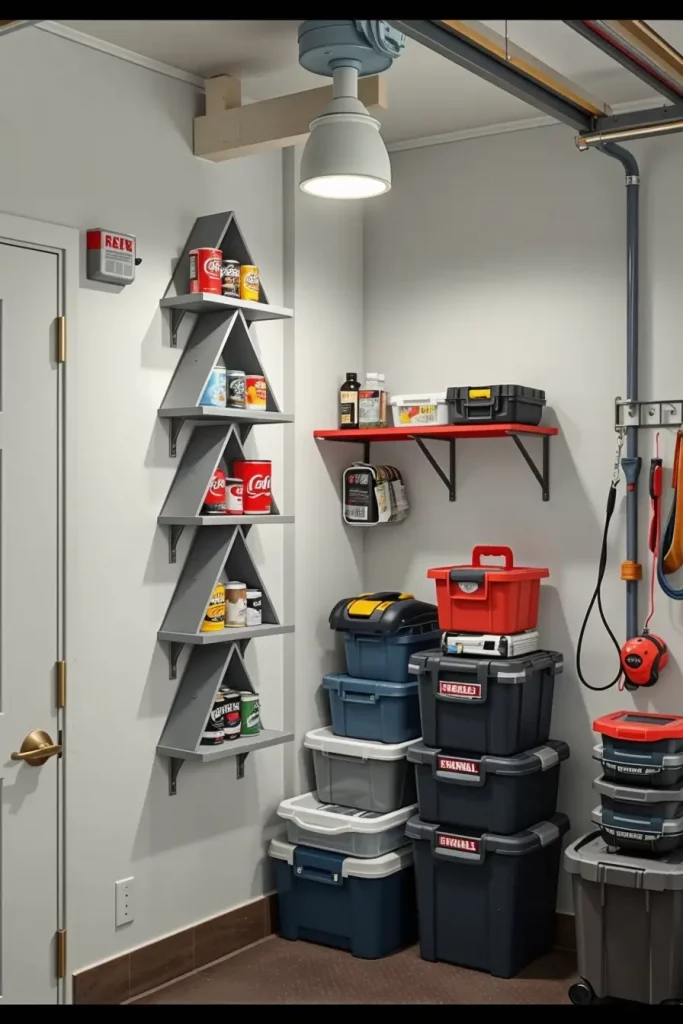
A client’s garage became organized, with an uncluttered cleaning supplies area in one corner. Bins and labeled shelves crafted a cleaning supplies organization system at the client’s garage. Better Homes & Gardens says that using up corner spaces provides more available space for movement and less clutter without enlarging the garage.
This further enhances the garage’s aesthetic value. My first suggestion would be installing lights activated by motion to the nook so that the area can be automatically illuminated and seamlessly integrated with the rest aesthetically.
Install Adjustable Shelving For Expanding Needs
In my experience, having adjustable shelving when attempting to organize a garage is a must because it works with your needs, no matter how they shift. Be it in the summer where you need space for gardening tools or in the winter where you need space to store holiday decorative items, these units have the ability to cater to vertical spacing needs. These shelving systems can run along an entire garage wall which will help in decluttering by organizing items into categories. For a more streamlined and modern look, I go for metals or reinforced composite materials as they can carry a considerable amount of weight.
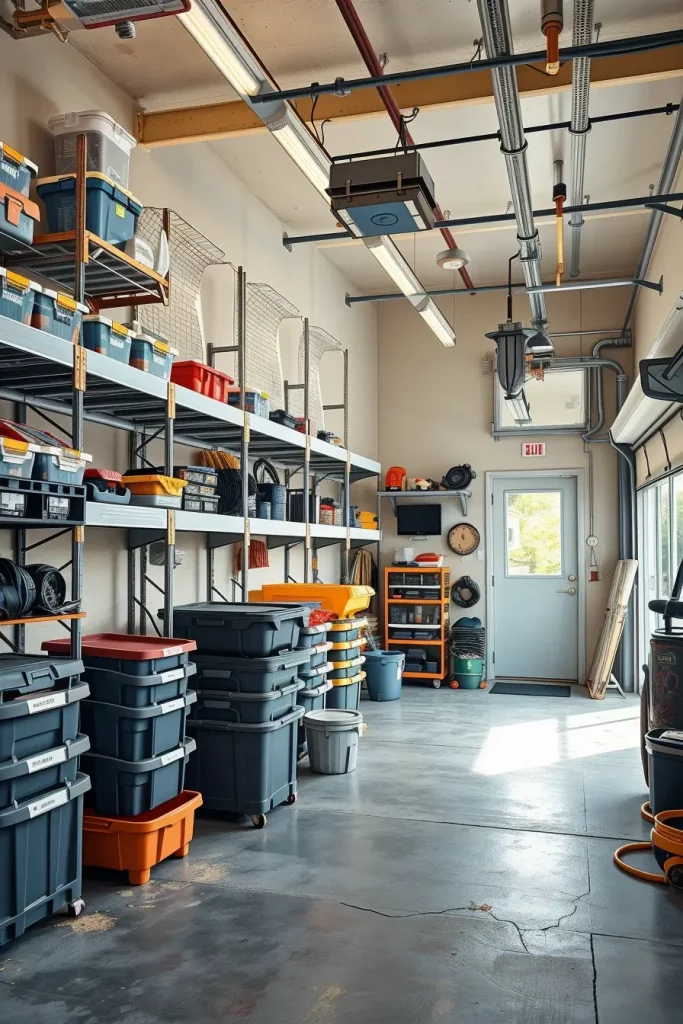
With large labeled bins, I try to use labeled clear bins that are stored inside heavy-duty adjustable wall units. These units generally come with steel shelves that have been powder coated and have interlocking slots which allows for a shelf to easily be moved up or down based on the height of the tools or containers being stored. Adding clear plastic bins with snap lids also helps as they can be labeled with bold waterproof tags which helps make everything visible and accessible.
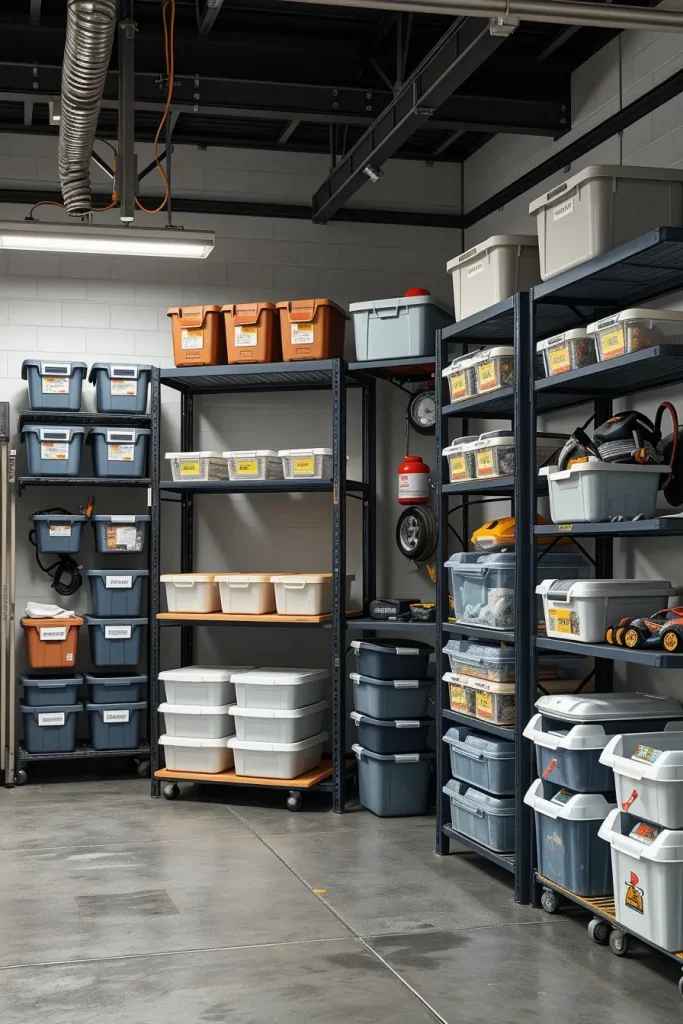
Speaking from experience, this system allows for freeing up space while still keeping essential items within reach. Bob Vila once pointed out that “shelves that change are essential for garages that serve as storage spaces and for hobbies,” and I couldn’t agree more.
To improve this arrangement, one could integrate lighting for the corners or add sliding doors to the shelves. That would enhance the practicality and the aesthetics at the same time.
Designate A DIY Project Bench Area
Turning a garage into a DIY project bench workstation elevates it from simply being a storage space. I always leave a specific spot for this – ideally close to outlets and under windows or well-placed lights. This area should accommodate small repairs, painting, crafting, or woodworking without obstructing the primary function of the garage.
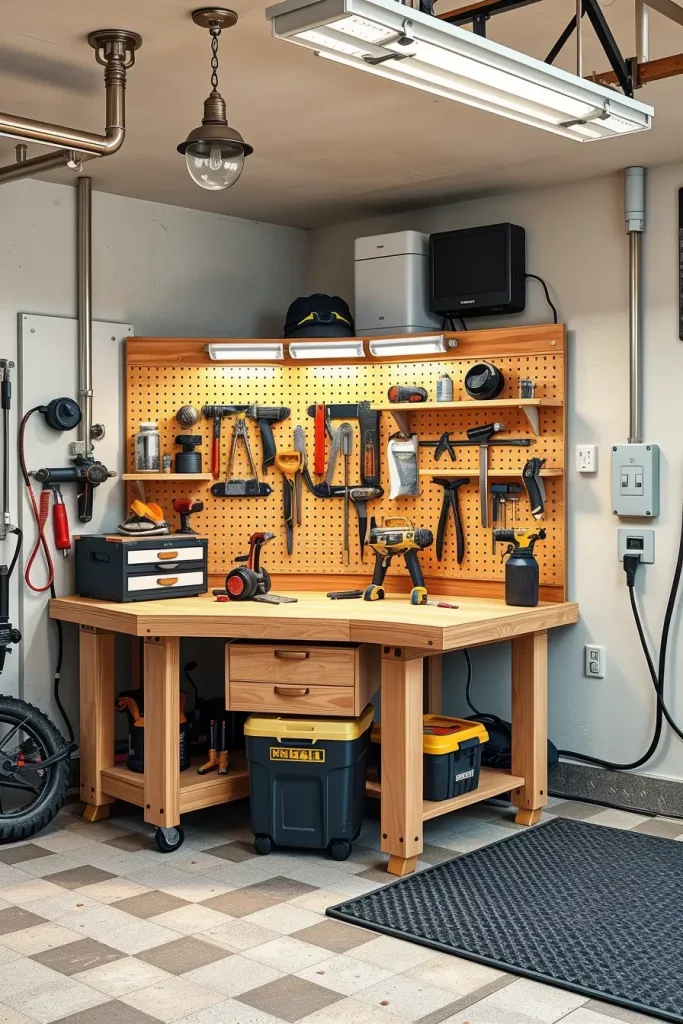
I set up a sturdy wooden workbench with drawers and a pegboard back panel to hang tools. The area is finished with a solid vice grip, under-shelf lighting, and cushioned anti-fatigue mats. I install shallow shelves above the workbench to hold paint cans and small toolboxes, ensuring every item has a designated spot while keeping the surface clutter-free.
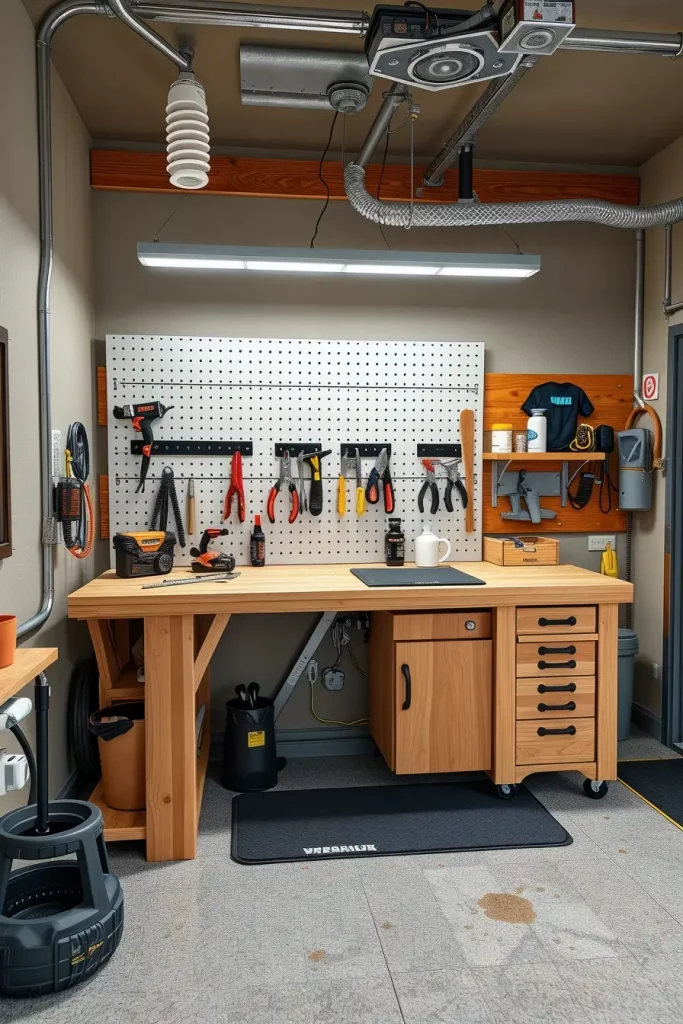
In my experience, clients who previously had no space to pursue their hobbies are now spending hours captivated in this new area. The Spruce suggests investing in ergonomic benches with locking wheels for a flexible space, and that’s a tip I use when working with limited space.
What could further optimize this setup is incorporating a clamp-on magnifying lamp and a magnetic strip for metal tools. This is a minor modification which greatly enhances usability.
Keep Dangerous Items Locked In Cabinets
Every organization plan for a garage must prioritize safety. If there are children or pets around, hazardous items such as pesticides, paints, and fuel must be kept in locked cabinets. I tend to use one side of the garage—ideally, away from the garage’s primary workspaces—for storing the chemicals.
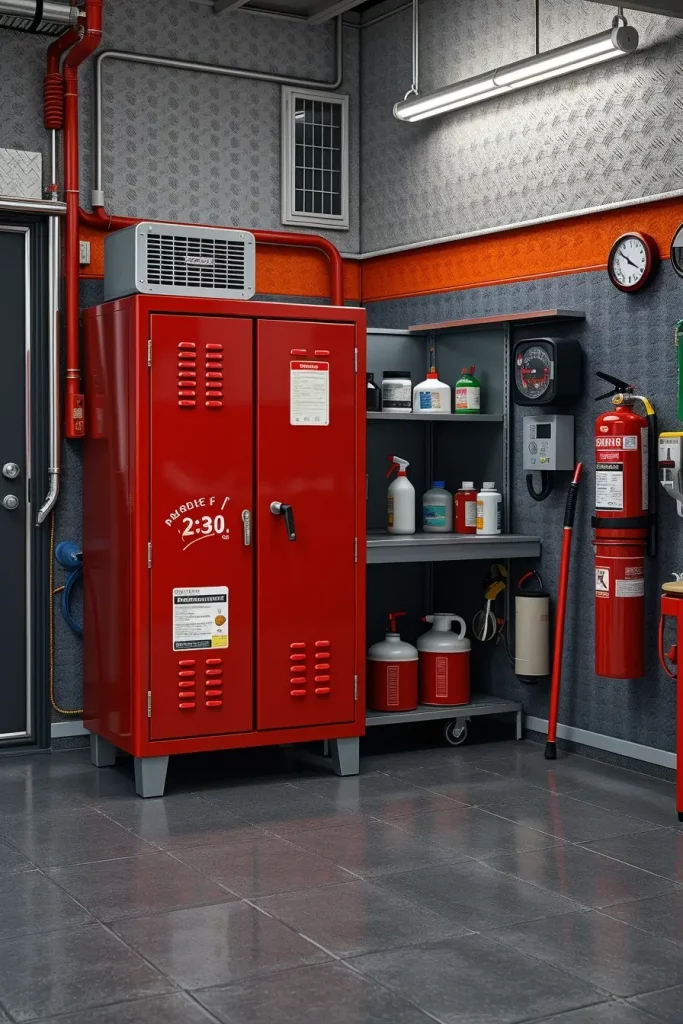
My preference is for cabinets made from metal that are also fireproof. They should contain a locking mechanism and vented back panels. These cabinets often come in bold safety colors like red or yellow and are anchored to the wall for stability. Inside, items are grouped into labeled containers with spill-proof seals. Just in case, I put a small sign with emergency contacts and first-aid instructions.
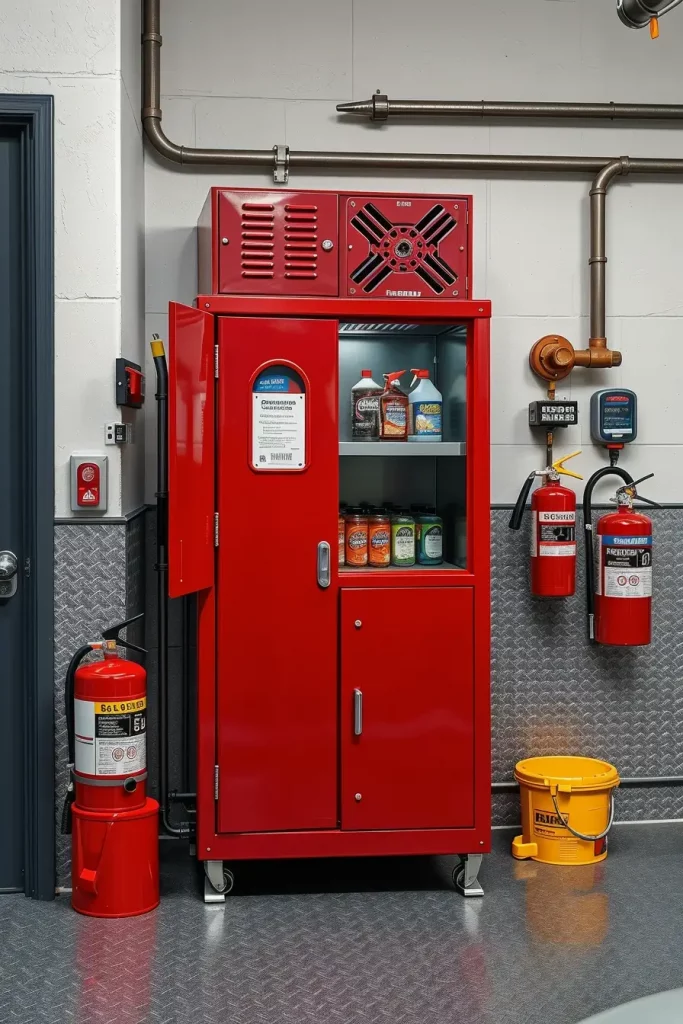
This design helped alleviate anxiety for several clients I had that lived close to these garages. The Home Depot blog emphasizes using approved cabinets that comply with OSHA standards, and I always follow that guideline.
To cap off this section, I would add a small fire extinguisher cabinet mounted beside the cabinet. It’s those little safety measures that make the most positive impact.
Hang Folding Chairs And Ladders On Hooks
This is an ingenious solution for garage organization. These wall-mounted hook systems help keep the ground and floor space free as well as store long and awkwardly shaped items out of the way. I usually dedicate an entire wall as a vertical storage grid for chairs, extension cords, and ladders.
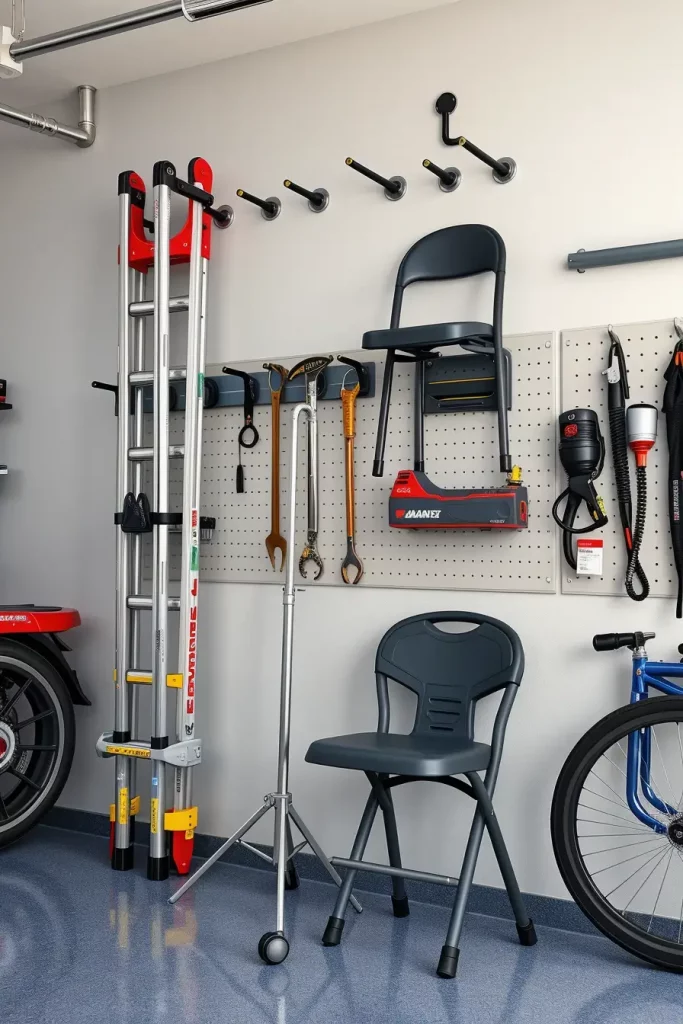
For the purpose of this design, I mount heavy duty track systems with adjustable rubber-coated hooks that can bear a great amount of weight. This method supports overhanging ladders which need be stored horizontally across two hooks to prevent warping, while folding chairs can be stacked vertically. Garage gathering events are made easier with this setup.
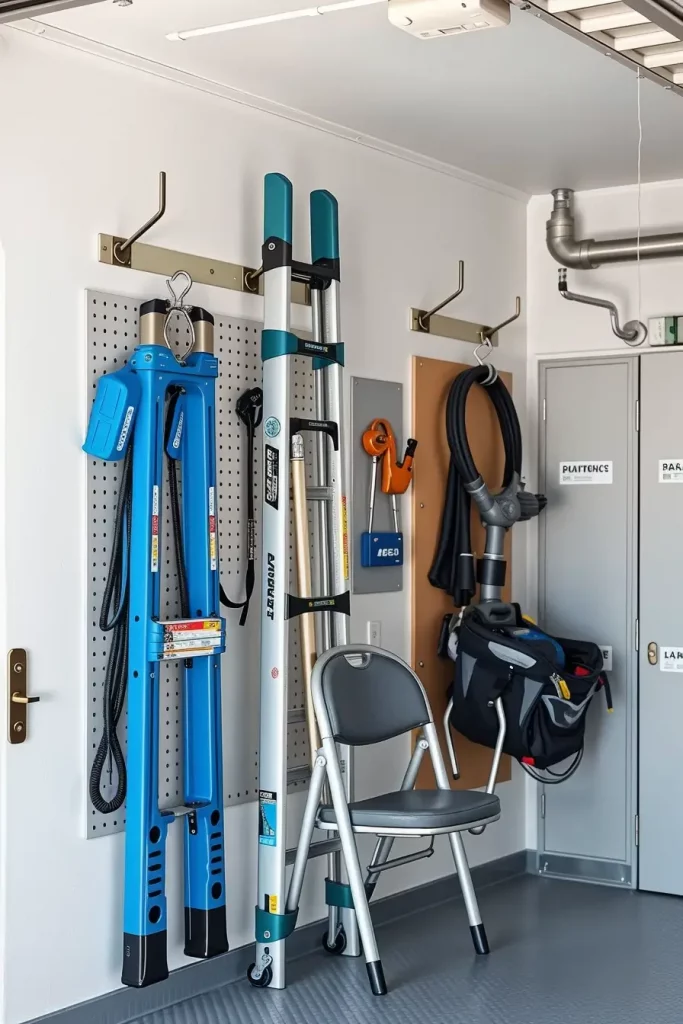
In my garage, this has been a space-saver. To organize a garage, I recommend wall-mounted utility panels featuring metrical grids designed for cord control and house beautiful space-savvy design elements to create tidy, elevated storage zones in small space regions.
For enhanced servicing, I might add clip-on systems which serve to improve the color or design of a supplied object identification table so users using color can easily remember where each item belongs.
Bungee Cords To Contain Bulky Toys And Balls
Sports equipment like basketballs and soccer balls are a challenge to contain in the garage. That’s why I use bungee cord storage; It’s low maintennace and cost friendly too. The bungee cord strip is simple and can be placed in a low corner that is easily accessible by kids.
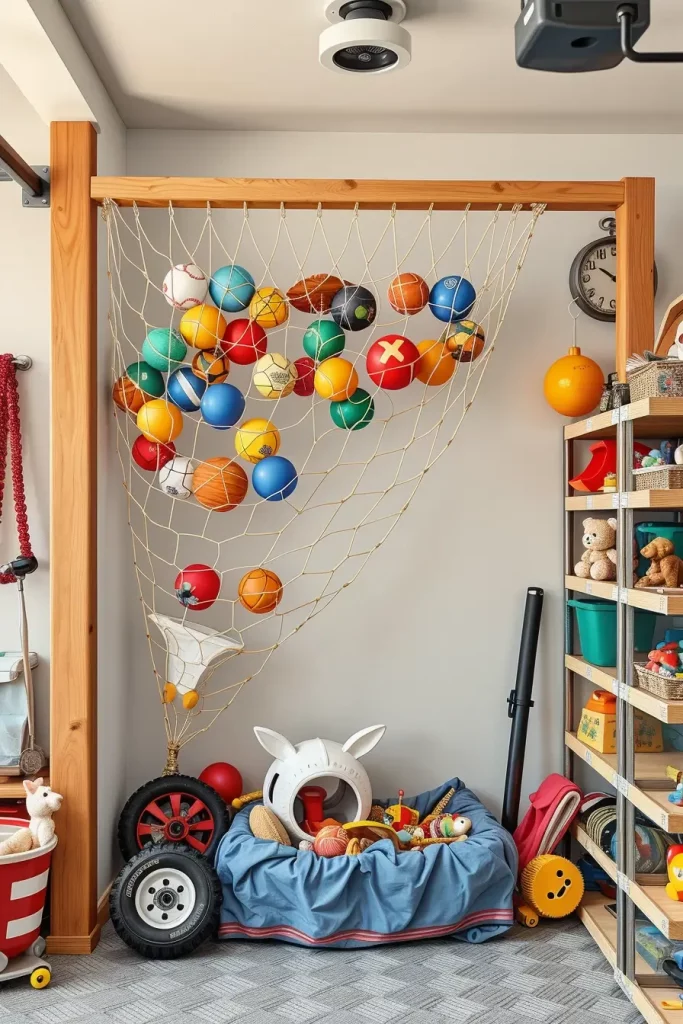
These nets or “toy corrals” can be made using wooden or metal frames with spaced horizontal bungee cords. I place balls above open shelves so they can be accessed quickly. Other gear like helmets are placed above the “toy corral” and all containers are labeled with plastic tags.
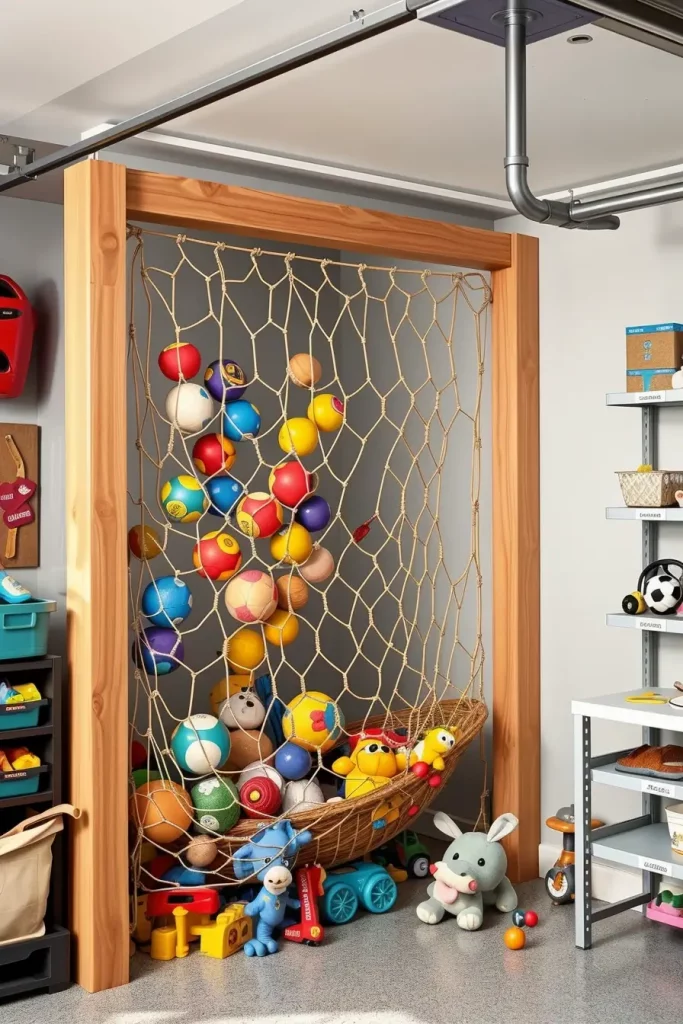
Bungee cord systems fulfill my clients needs because they help kids manage their gear. “Return stations” like the bungee cord strips have also been recommended for promoting general tidiness in family garages. The approach is efficient and simple.
To complete the setup, I would add a bench along with cubby holes in close proximity with the bungee cords for shoes or skateboards.
Build A Charging Station For Your Tools With Cable Management
In every garage, battery packs, chargers, and cords seem to pile up. A garage is home to a charging station with a tangled mess. An organized station helps improve the overall chaos and promotes battery health, which is a plus. It is usually located next to a workbench or in wall outlets, alongside windows where drill visibility and ventilation is ample.
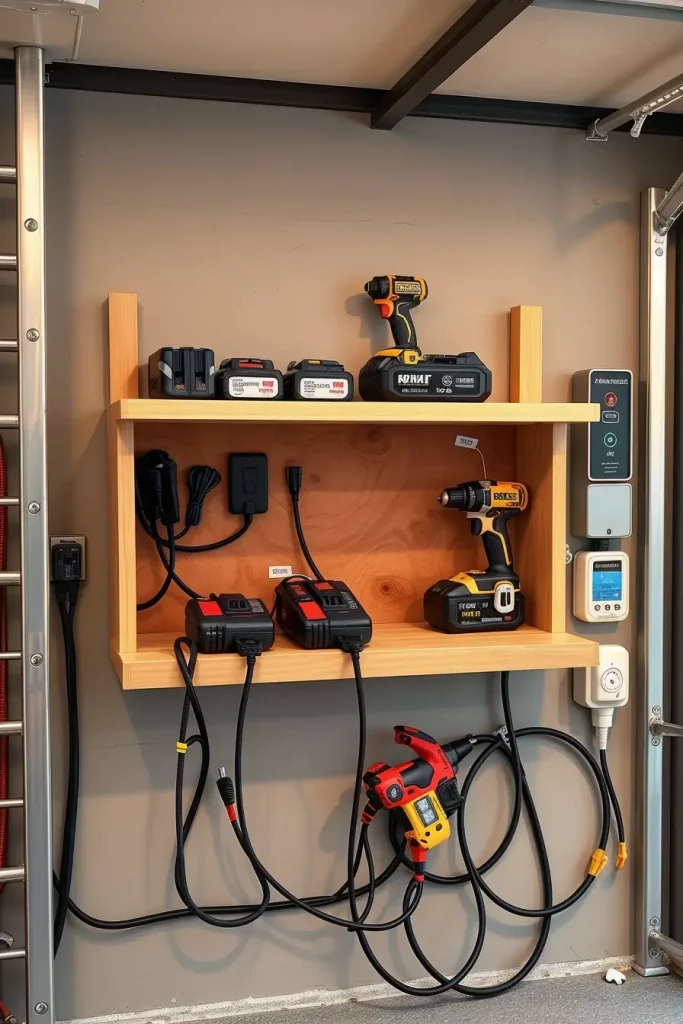
A labeled shelf is cut out with each shelf having small holes designed for charging cables to the rear. Each shelf is designated for a specific tool or device. I also incorporate a built-in surge protector alongside wall clips for better cord management to control the mess. The small drawer beneath the shelf holds extra batteries and instruction manuals.
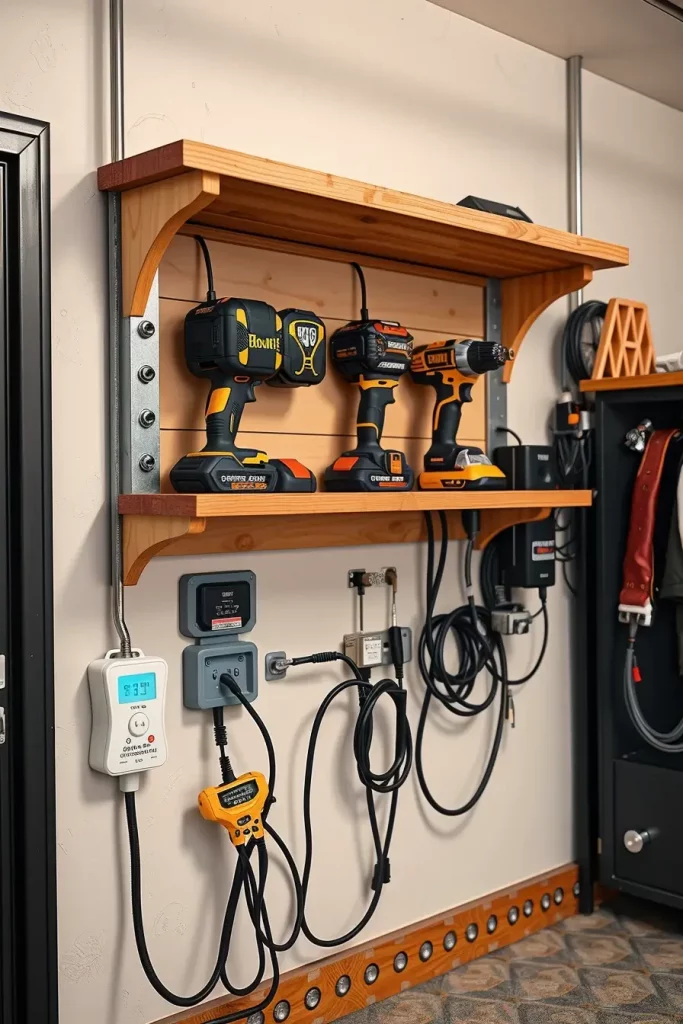
From what I have documented, this setup has greatly improved order and tool longevity. With the information gathered from Popular Mechanics, the lifespan of batteries is optimally managed when they are organized within a controlled environment – and this station does exactly that.
Battery gauges can be viewed from a distance, which can be done by attaching a small LED strip under each shelf. For drills, this feature can be used on active chargers to illuminate battery drape lights.
Use Small Parts Organizers For Screws And Nails
Every garage decor system mandates the need for effortless management when it comes to dealing with half-open packets of nails, screws, washers and bolts. For maximum spatial efficiency, I fix small parts organizers to a wall or the insides of cabinet doors. This allows retrieval and storage of every single item in an orderly sorted labeled manner.
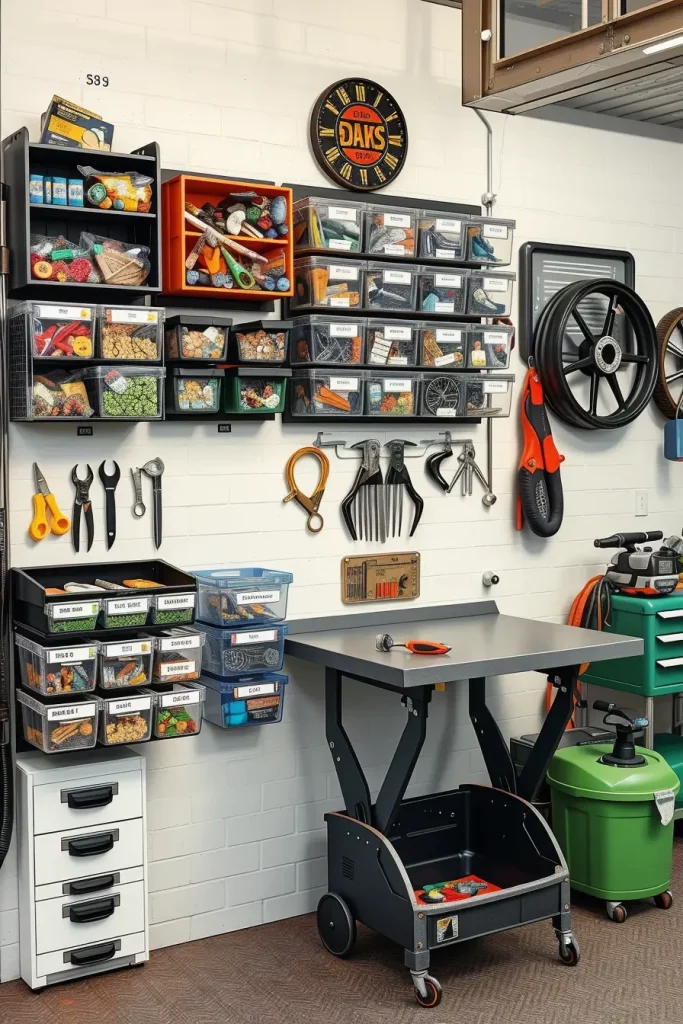
I use stackable clear plastic drawers as well as wall-mounted compartment boxes. Each drawer is clearly labeled and I sometimes even color-code them by size or type. These sorts of organizers are ever so handy and get placed right adjacent to the workbench or DIY bench, which helps maximize occupational efficiency. Another add-on is a magnetized dish I provide for temporarily holding items during projects.
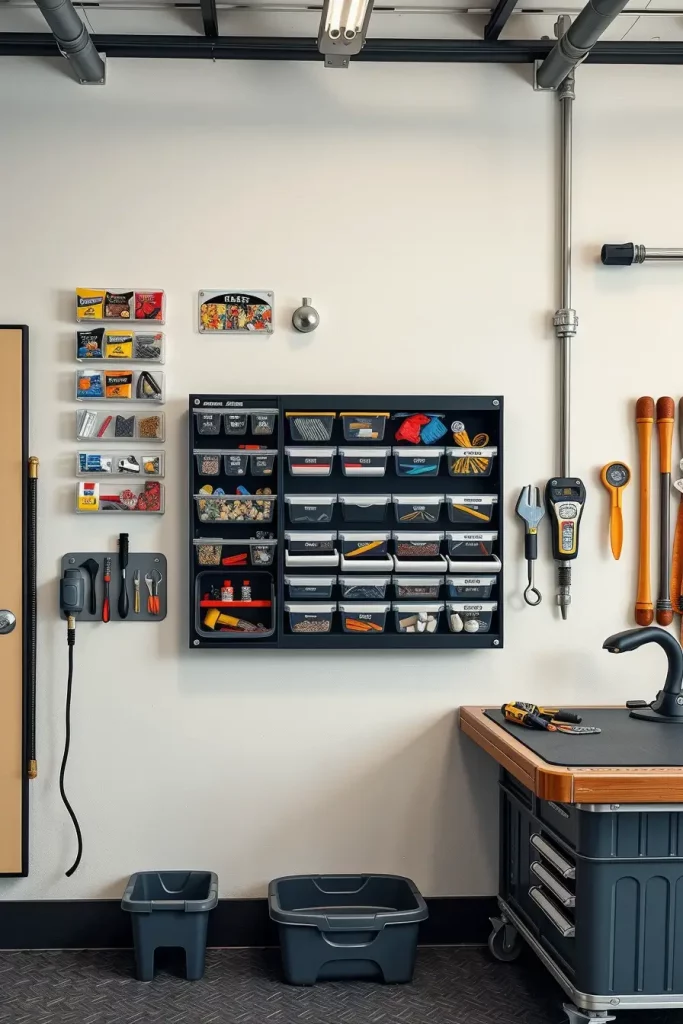
All these years, I’ve noticed that places that are specifically allocated for small parts goes a long way in avoiding needless purchases and time lost looking for things. Following Lifehacker’s tip about labeling all drawers and grouping by function, which I follow religiously, is a game changer.
To make it even more useful, I’d integrate a fold-down mini table underneath as a sorting station, providing a way to seamlessly toss pieces, fit, and assemble them mid-assemble.
Upgrade Lighting For Better Workspace Visibility And Safety
Inadequate lighting is one of the most underrated issues of an organized garage—and one of the most important at the same time. A garage with insufficient lighting will bring about problems with trying to locate things, pose a safety threat, and demotivate the user to avail the space for organizing. In all of my projects, I start with windows, if any, and add light layers like overhead units, task, and accent lights where appropriate.
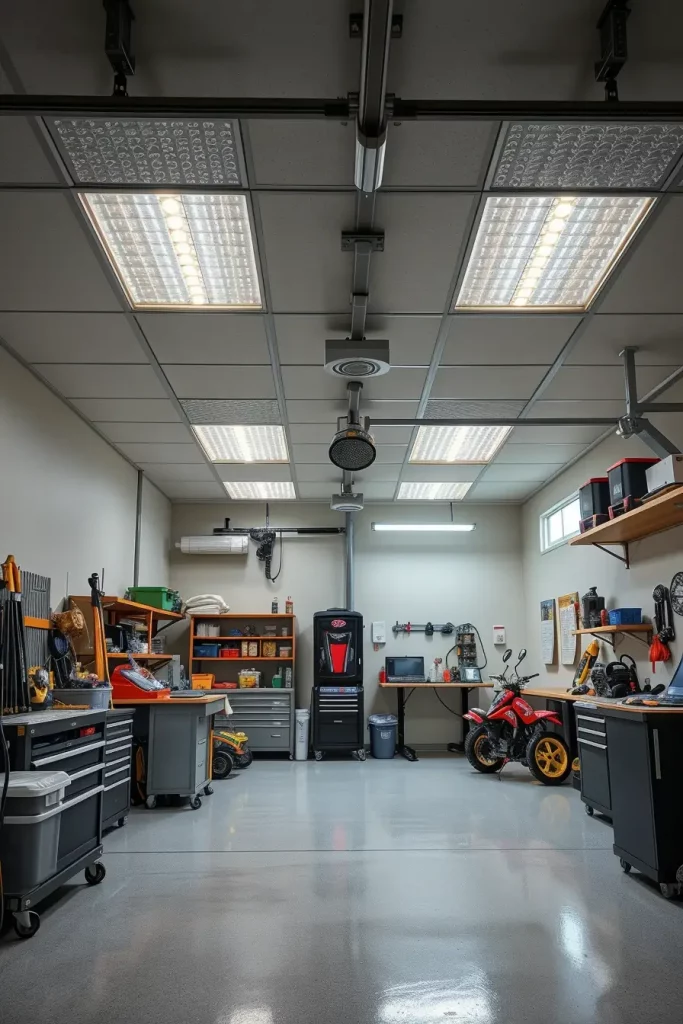
For my designs, general lighting is achieved with high lumen led ceiling panels. These provide superb energy savings and cuts down on shadows. Over the workbench, I install adjustable directional task lights. In dark alcoves or the insides of large shelving units, I install motion-activated puck lights or led strips. The difference from the old “bulb” system to modern bright LEDs and other systems is instant.

Clients often hear me say these days with the right lights one garage can feel twice as spacious. As noted in This Old House, the degree of illumination in a garage has a significant impact on the safety and efficiency of the space, especially for people operating tools and machines. I couldn’t agree more that additional lights really do add so much to a space.
To take it a step further, an increase in convenience comes from adding electronic devices smart lighting controls or sensors which aids in electricity efficiency.
Layout A Paint Supply Shelf With Brush Holders
In most cases, paint cans, rollers and brushes end up collecting in an untidy fashion which will result in ineffective space utilization as well as spoiling the tools. To remedy this problem, I construct customized paint supply shelves that organize the plies and make them easy to identify. Typically, this spot works well for being placed on a small wall space adjacent to the DIY workbench as well as next to a utility sink if one is present.
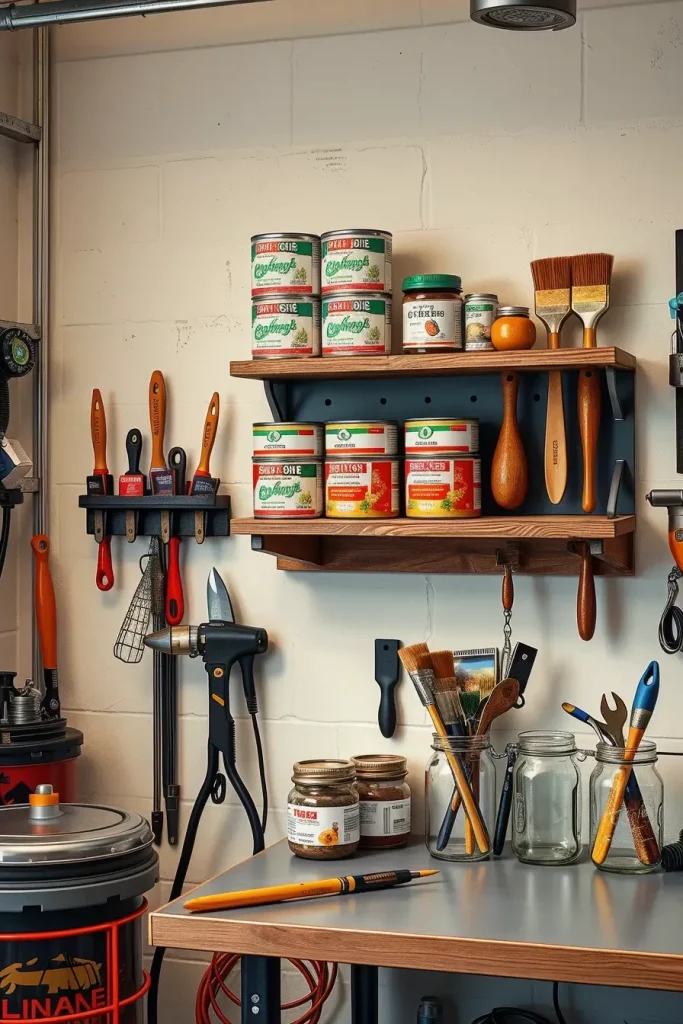
Overhead, holders made from PVC pipe sections maintain brush bristles, while stir sticks and paint keys are stored in mason jars or metal tins. A dowel rack mounted above holds drop cloths, and a frame-less glass door enclosure keeps oversize shelving units looking tidy. To the side, a urged cap catches onto a screw protruding from the wall and prevents wasting paint during shipping. These designs eliminate potential spills and expensive materials being damaged.
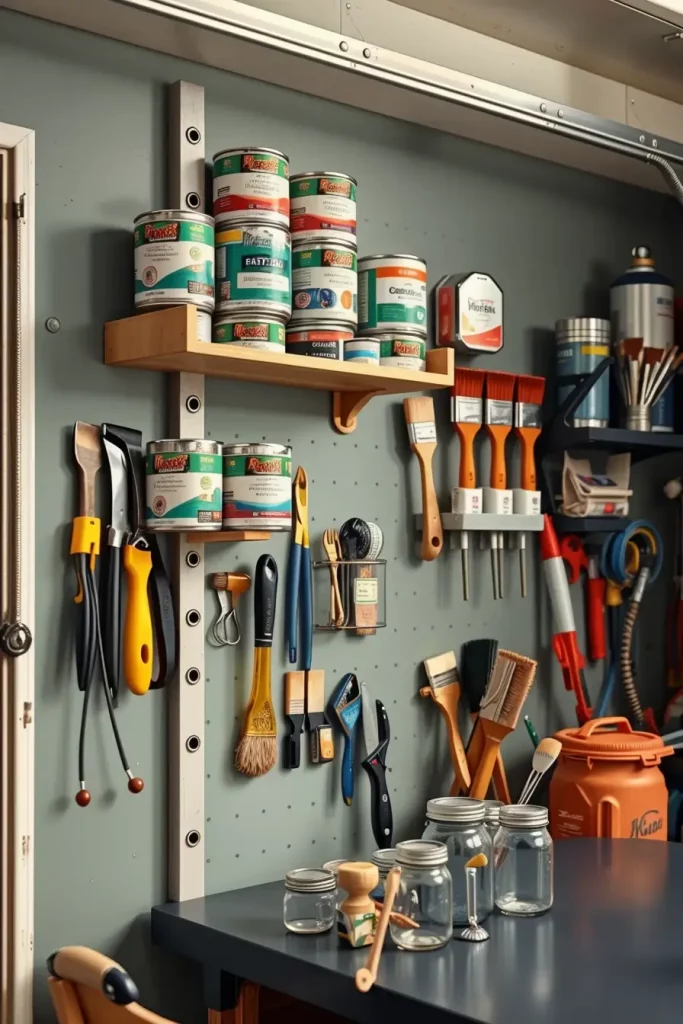
My personal experience working with artists and handymen has revealed that having a dedicated shelf clearly laid-out increases the efficiency of your work. This organized design permits better project monitoring which improves finishing times. Better Homes & Gardens disapproves of extreme heat and cold for paint storage, one more reason for using walls away from windows or drafty corners.
Further in this regard, I would suggest the installation of a mini fan for cooling freshly cleaned brushes along with attaching a whiteboard to record open can dates and other relevant details.
Effortless Way of Sorting Recyclable and Non-recyclable Bins
Every automated garage makes use of an effective area for sorting waste. I personally add in trash and recyclable bins that are simple to empty and care for, which is placed near entrances of the eqipment or near the steps of the house.
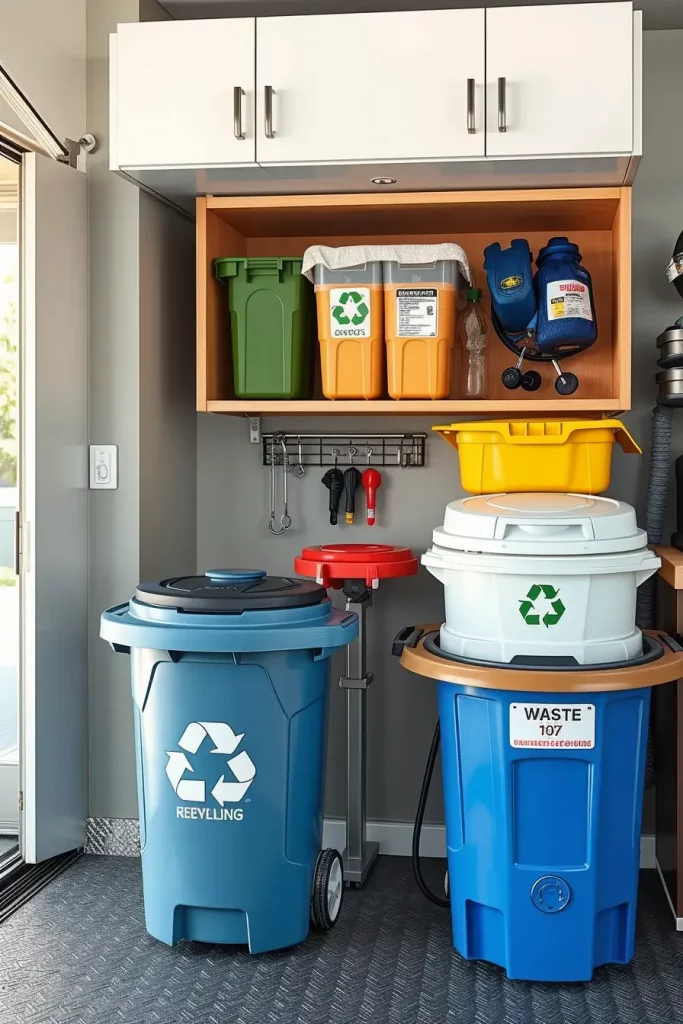
In my case, I do a combination of blue for recycling and black for trash, and of course green for compost in case it’s going to be utilized down the line. These great cans are mounted in slide out drawers within a wall cabinet or on a sliding metal track organized beneath a work area. To improve usability, every bin is equipped with a step-on or soft close lid and laminated tags showing the sorting title is added to assist children and visitors.
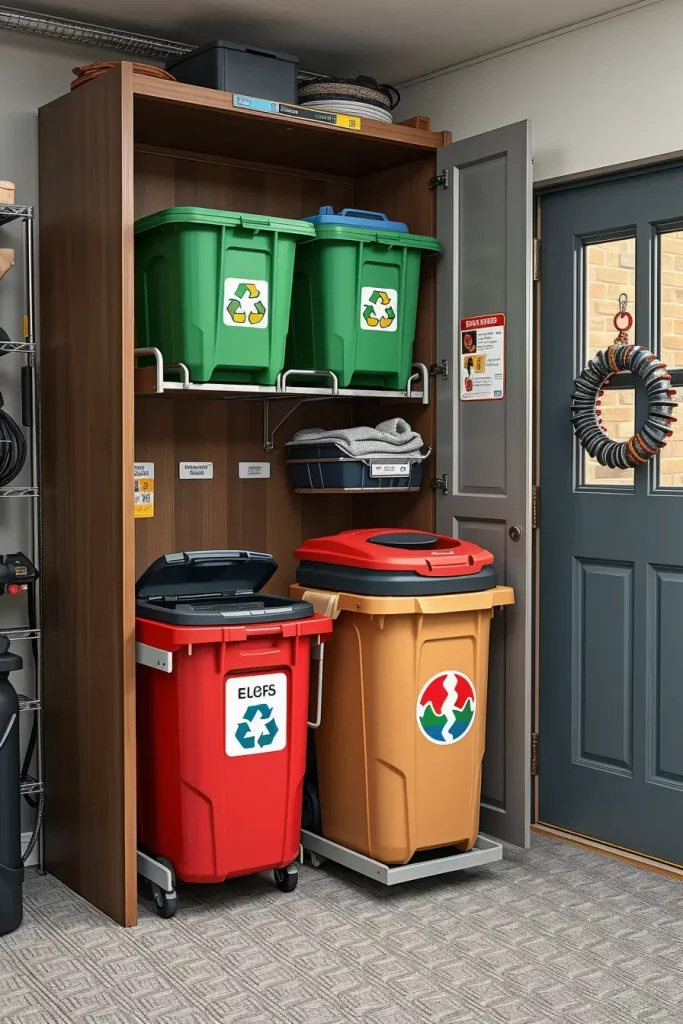
Using this system helps your customers save space and reduces visible dirt. A suggestion given by their control center is to build the base for the trash directly into the DIY workbench which I find myself often doing.
There’s the option to control the odor using a motion-sensor activated odor eliminator placed above the sorted bag sections. All of these might not be life changing but over time turns into a huge convenience.
How To Set Up a Workshop Wall With Power Tool Mounts
For anyone who regularly works with power tools, fixing or building something mechanically inclined, organizing a workshop wall with tool mounts is critical for organization as well as safety. I use an entire wall for this purpose which is usually by the sockets and reachable from my DIY workbench so that heavy tools can be stored safely and accessed easily.
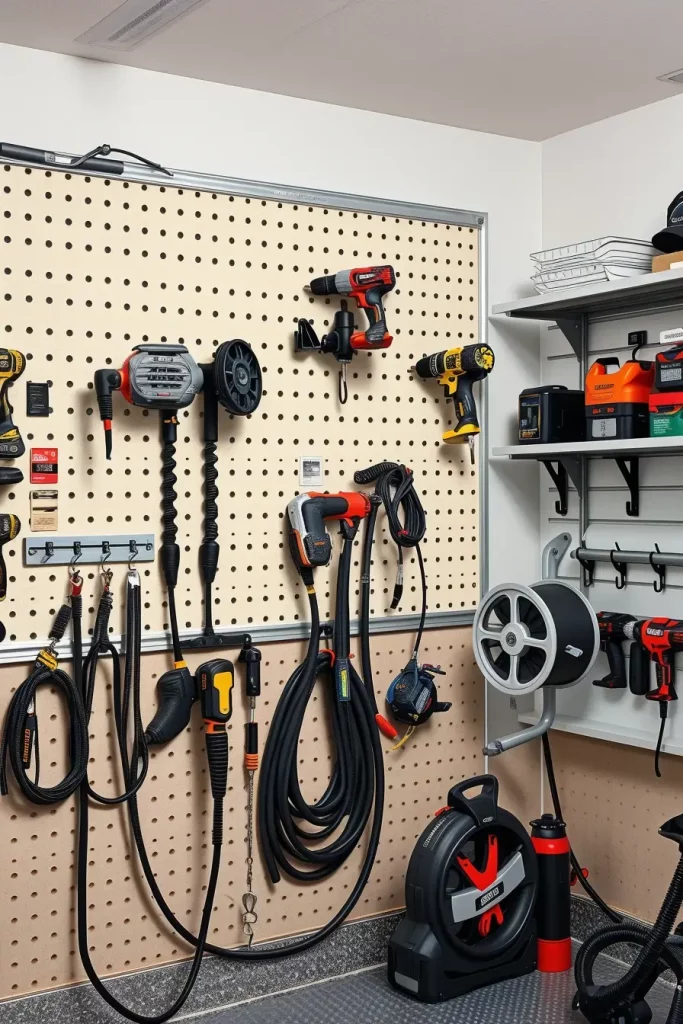
I mount each power tool—be it a drill, sander or even a jigsaw—on the pegboard or slat wall using universal mounting brackets and custom shelves. The mounts each sit atop small shelves which can keep additional accessories. Each mount has a shelf for the accessories such as the drill bits and sander pads. Cable hooks keep the cords neat and outlines of the tools drawn on the pegboard ensure each item is returned to its designated spot. Above the setup I mount the retractable extension cord reel for easier access to power tools.

This setup has proven to optimize my clients workflow and make them more inclined to utilize their tools to their maximum potential. Family Handyman recommends placing outlines for each tool and marking them as a frame, which is one of the many tips I have come to love passing on.
In further hypothetical scenarios, I would integrate features to keep track of tool maintenance and battery life such as a QR code labeled inventory tracker and digital inventory scanner.
Make Use Of Door-Back Storage With Shoe Racks
Storage inscribed on the back of doors is incredibly useful in maximizing the available space in a garage area. In my case, I use the back of each door leading to the external part of my house for shoe racks.
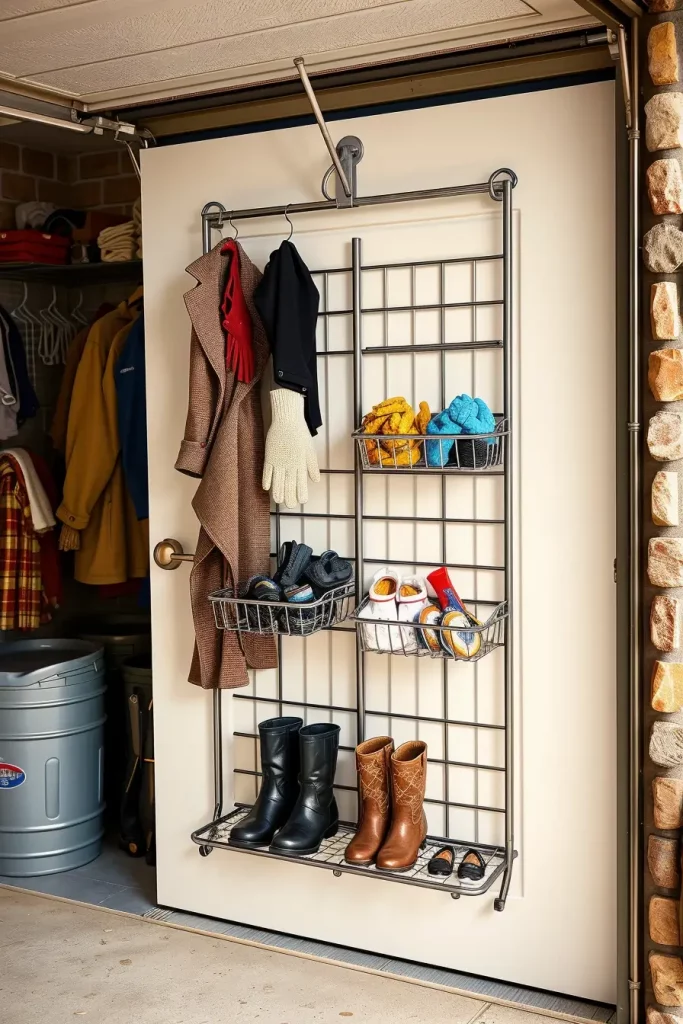
This type of door storage is particularly efficient for the management of assorted winter wears such as gloves, shoes, and other sports related goods. For maximum efficiency, I make sure that heel and Velcro strips are used to secure such racks into place as these ensure that standstill is guaranteed.
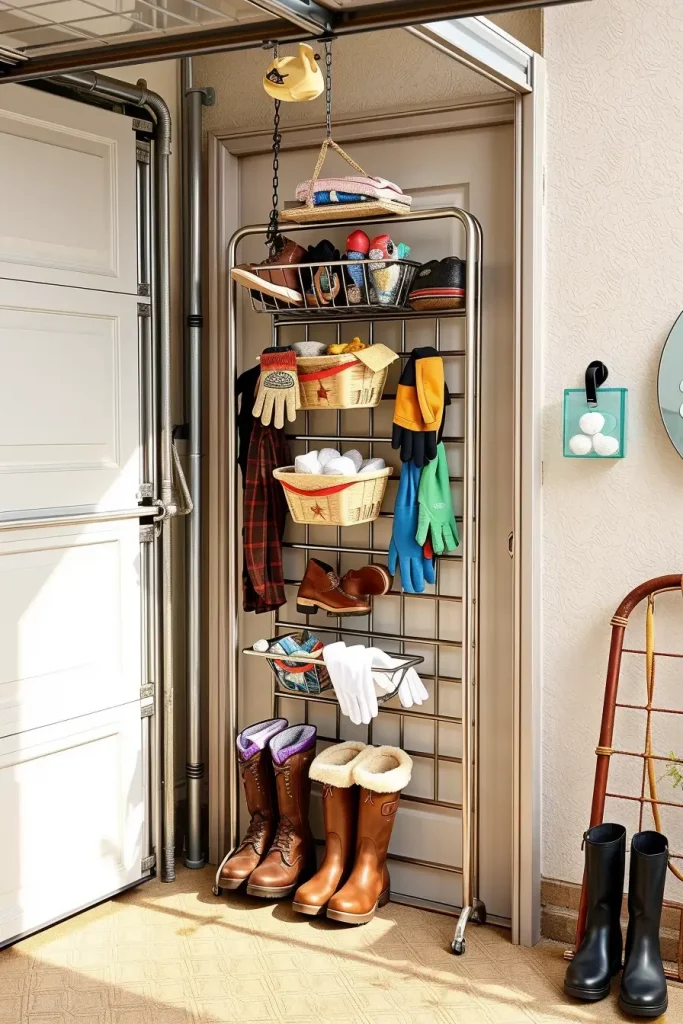
Alongside other clean and dry bath products, this DIY also serves to beautify the arrangement of wet work boots and shoes placed on this closet organizer. For my family, the accessible shoe organizers trigger clutter control which contributes to combating dirt and filth.
To spice this DIY, I would recommend attaching a heat pad directly causing vaporization to occur spring and summer months.
Transforming a Rolling Cart Into a Mobile Repair Kit
A rolling cart repair kit is one of my favorite setups. Fixes around the house can be done efficiently without dragging a toolbox, and home repairs are much simpler. I keep it handy in my garage to be used instantly—either tucked in the center aisle, or just outside the main garage door.

I make use of a cart with three tiers, divided into sturdy plastic and metal trays. The top shelf is reserved for basic tools, like screwdrivers and pliers. The middle tray has small bins that accommodate nails, anchors, and fittings. While the bottom shelf contains rechargeable drills, gloves, and safety glasses, I also add cup holders for pilot holes. Some added features include a magnetic strip on the sides for rapid tool retrieval.
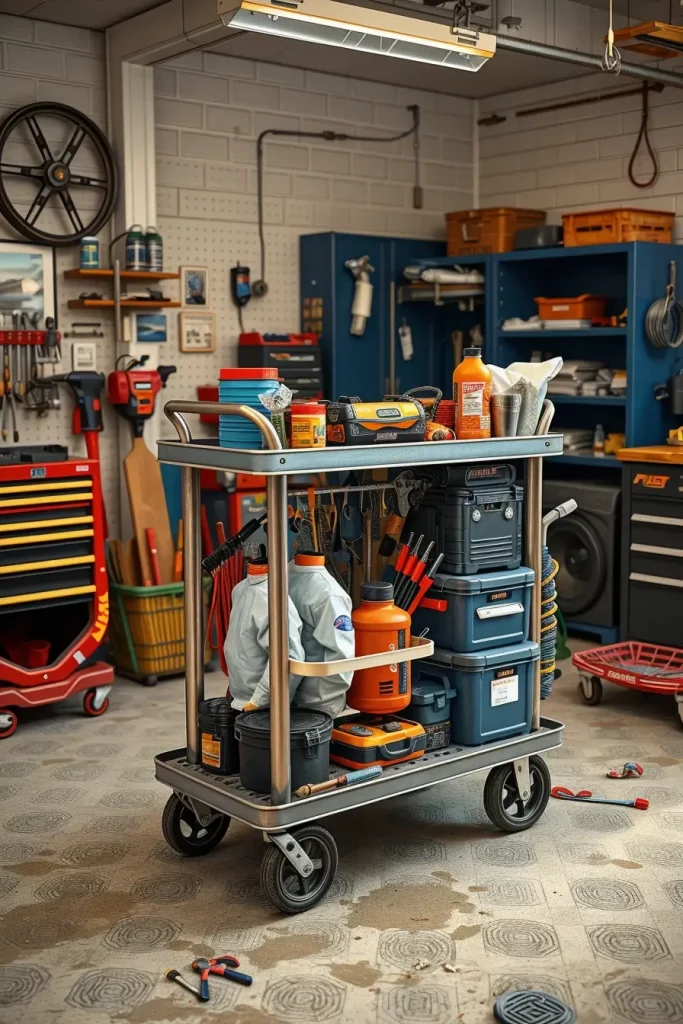
Clients adore this configuration because it allows users to work independently, reducing time spent on tasks. Mobile workstations are highly recommended by Bob Vila to anyone who regularly tackles household tasks, and ever since I implemented this solution, I have received quite a number of praises.
For future improvements, I’d consider clip-on instruction cards for streamlined repairs, as well as a clip attachment for phones or instruction booklets, enabling hands-free viewing.
Make Use of Vertical Sliding Drawers for Small Parts
Vertical sliding drawers can be a game-changer when it comes to design and spatial constraints. These drawers are placed within slender wall cavities and pull out like kitchen cabinet pulls, perfect for storing small garage items like spray bottles, rags, or hoses.

I install these drawer towers between wall studs or as a component of a custom storage wall. The individual drawers are fabricated out of metal or laminated wood, equipped with adjustable compartments, and utilize ball-bearing slides to ensure effortless opening. Set edge labels discerned from the drawer’s edge highlight softer features like dividers on bolts, while soft open ensures that ‘slamming’ is out of the question.
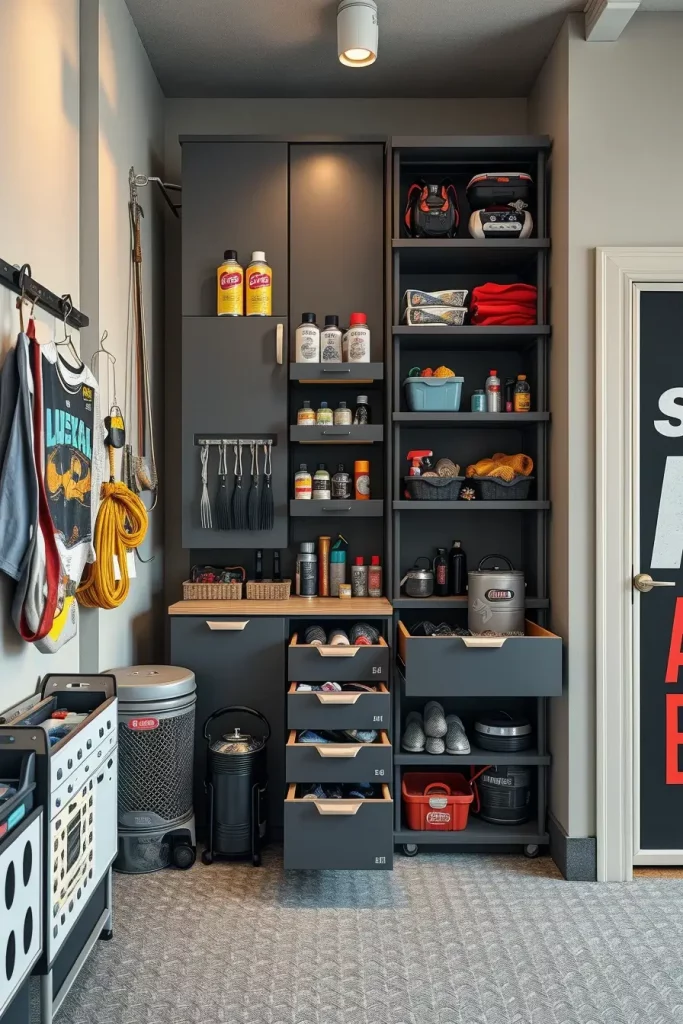
Vertical storage in limited spaces has proven tremendously useful, and these systems showcase how clients are comfortably astounded by what they can save and store in their previously overlooked and “dead” areas.
I would suggest adding additional features like motion activated lighting to provide illumination during drawer access to enhance this configuration.
Construct A Compact Lawn Tools Equipment Station
During garage organization, one area I try to pay attention to is “utility” zones and one of the most messy utility zones is where all the lawn equipment gets stored. For this purpose, I usually suggest the construction of a compact lawn equipment station. This is some sort of a storage area which contains everything from lawn mowers to fuels like trimmers and fertilizers. This design usually comprises of a tall corner cabinet, vertically mounted hooks with vertical racks that keep components orderly yet easy to reach.
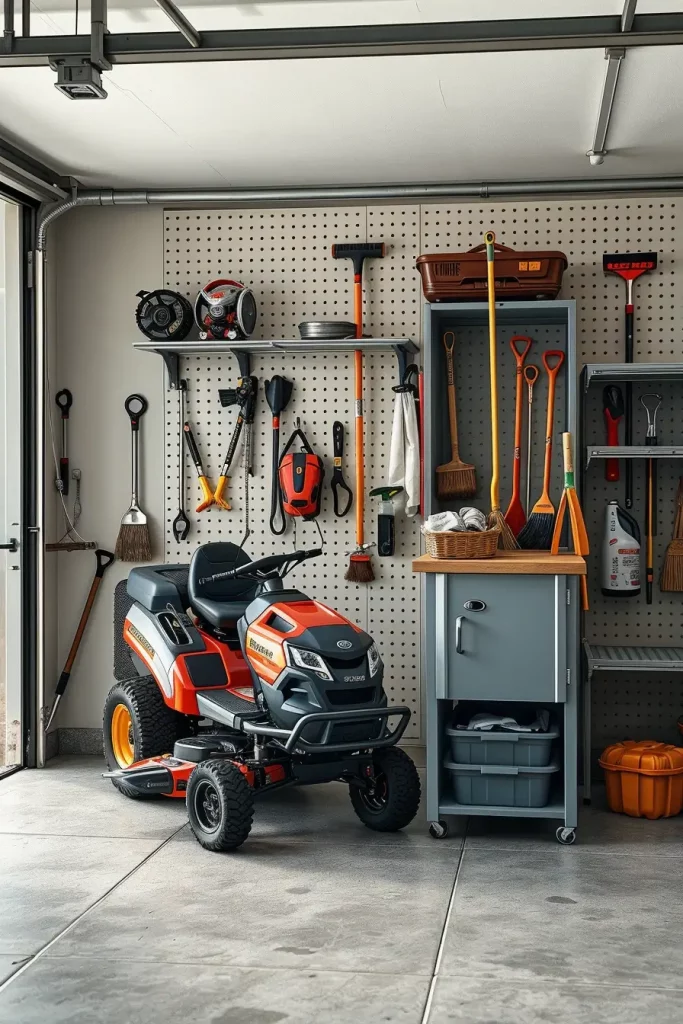
In such arrangements, I always make sure to add a metal utility cabinet with adjustable shelves to store smaller tools along with out of season lawn items. I also suggest mounting pegboards vertically so that rakes, brooms and even weed whackers can be hung on them to save space. There is also a provision for additional bottom storage where I add a shelf which contains bins to store gloves and spare parts. Such vertical arrangements provide space clearance and maximize the floor area of the garage.
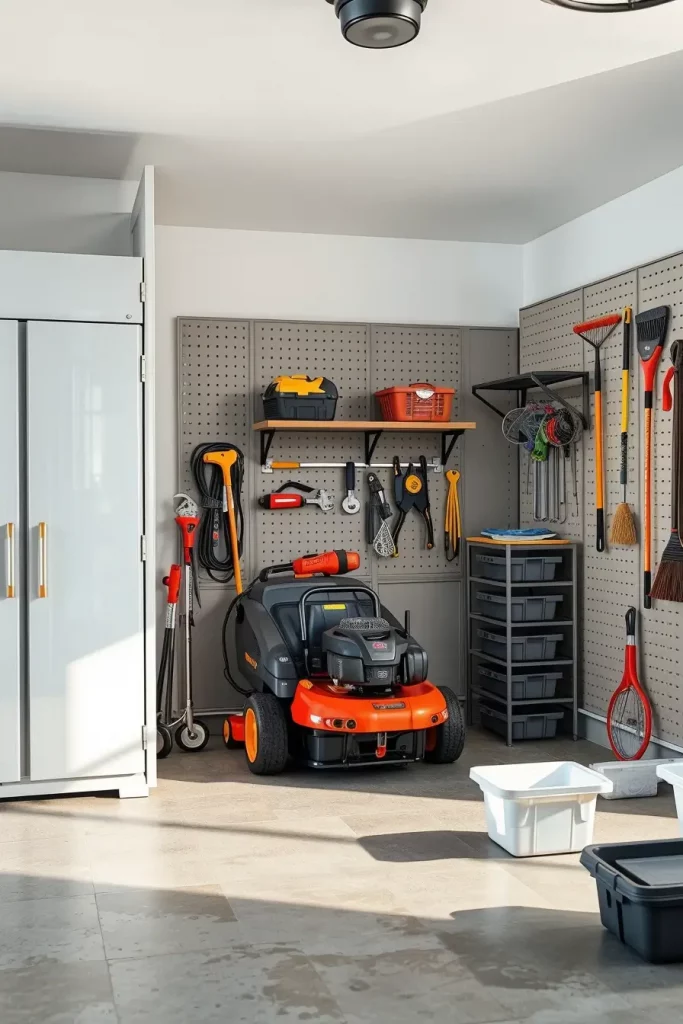
Such an arrangement personally saved me an incredible amount of time during weekends and pushed the number of my hours spent preparing down for mowing the lawn. Instead of having to sort through bucked and go through a lot of different bins, I can now directly reach for the lawn shears and hose fittings. Better Homes and Gardens cites vertical storage as one of the best ways to add more usable storage in garages and I cannot agree more.
To further improve this section, I recommend adding a pull-out drawer system that fits underneath the main shelf or underneath the cabinet. This would make accessing twine, sprinkler heads, or spare hose nozzles easy, ensuring these items never get buried beneath heavier tools.
Utilize Color Coding To Distinguish Areas Of Storage
A color coding system is, in my experience, the most effective visual method for organizing the garage. Whether you’re sharing the garage with family or would just prefer to locate things at a single glance, color makes it effortless. I suggest assigning hues to every category: blue for automotive supplies, green for gardening, red for sports gear, and so on. It immediately removes any uncertainty.
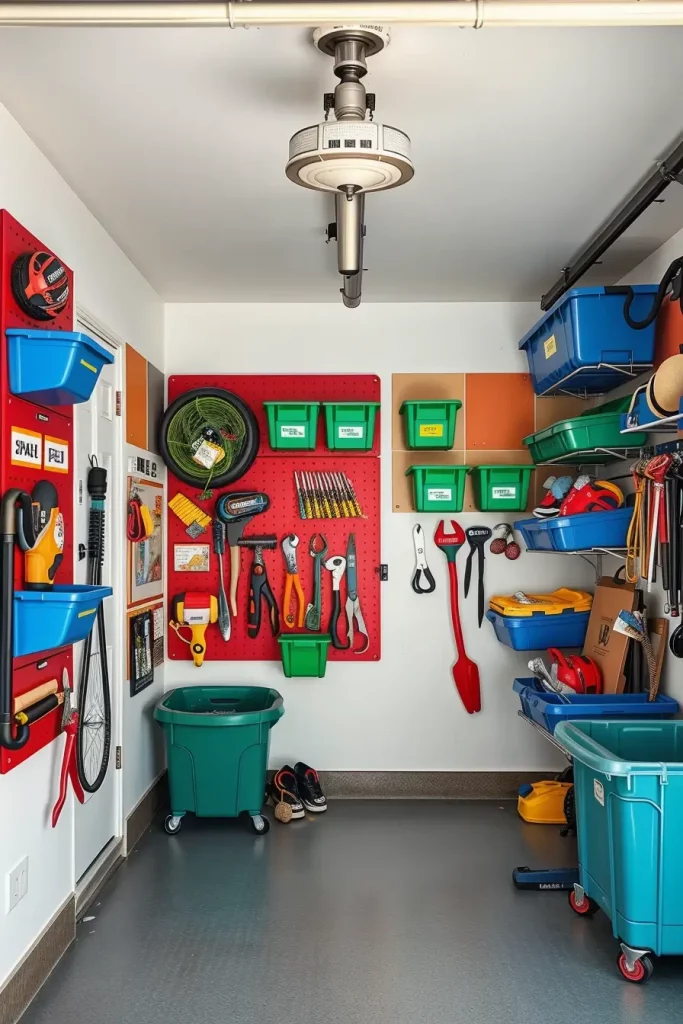
In practice, I combine labeled wall decals with bins, using matching colors for each category. A green-lidded bin means yard supplies, and red pegboard sections are for biking gear. To make it obvious as to where things belong, I even color the handles of hooks with electrical tape. To further define areas, I use painted zones on the wall or floor—like a blue strip along the wall under the tire shelf for automotive tools.
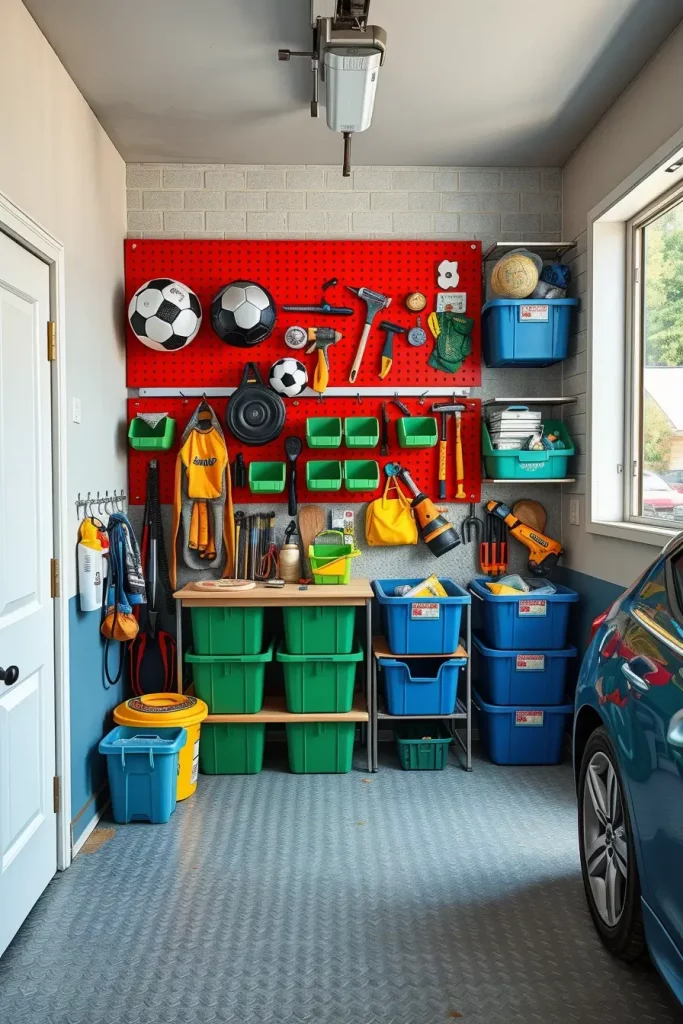
On a personal level, this aids in decluttering a space from unwanted clutter. Everyone in my household manages their things, which keeps the order intact without me needing to clean up all the time. Even the New York Times WireCutter section recommends using bold labels and color schemes to organize shared garages to reduce usability issues among users.
If I were to add anything, it would be a printed key hung on the inside of the garage door—a legend showing what the colors represent. This simplifies the system for guests, kids, and other aides.
Install a Foldable Table as a Work Surface
A workspace is essential for every well-organized garage, but not everyone has the space to accommodate one. This is where I firmly believe in the value of a foldable table like this one. It provides a dedicated work surface that can be stowed away when not in use, which is excellent for space-starved garages.
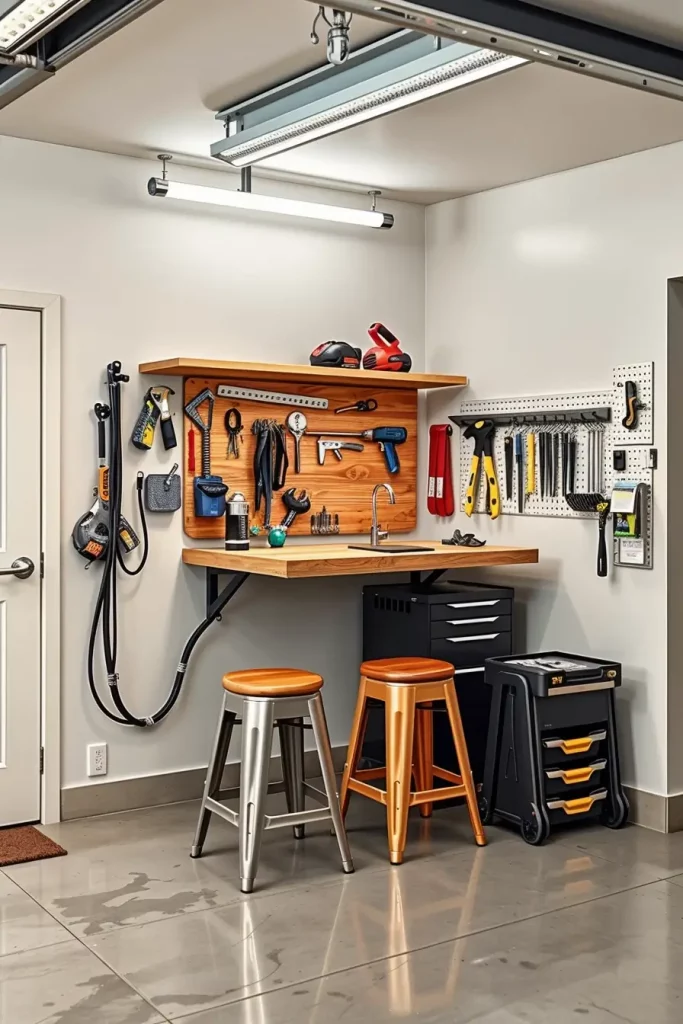
For stability, I typically use a wall-mounted table with heavy-duty locking metal brackets. Underneath, I allocate space for stackable stools and shallow drawers that slide vertically on the wall, which store essential items such as measuring tapes, screwdrivers, and masking tape. LED strip lights installed above the station illuminate the area for precision work. The goal is to maintain a minimal area, but one that is complete, unobstructed, and usable.

This design works great for small DIY projects and other small tasks. It doesn’t take up any parking space, plus when it’s folded down, it becomes a well-organized tool board. Popular Mechanics also recommends fold-down designs like these for multifunctional garages where every space has to count.
What I would like to see more often is a magnetic tool strip above the table so important tools are not only readily available, but also neatly displayed even when the table is up.
Monthly Maintenance: An Order Strategy
Organizing the garage is a one-time job but reaching order in it is a lifestyle choice. For every chaos there is a solution. One of the most effective garage organization strategies I’ve adopted is a maintenance plan that takes place every month. Rather than letting chaos organize itself, I set a specific day in a month where I clean, organize, and restock materials.
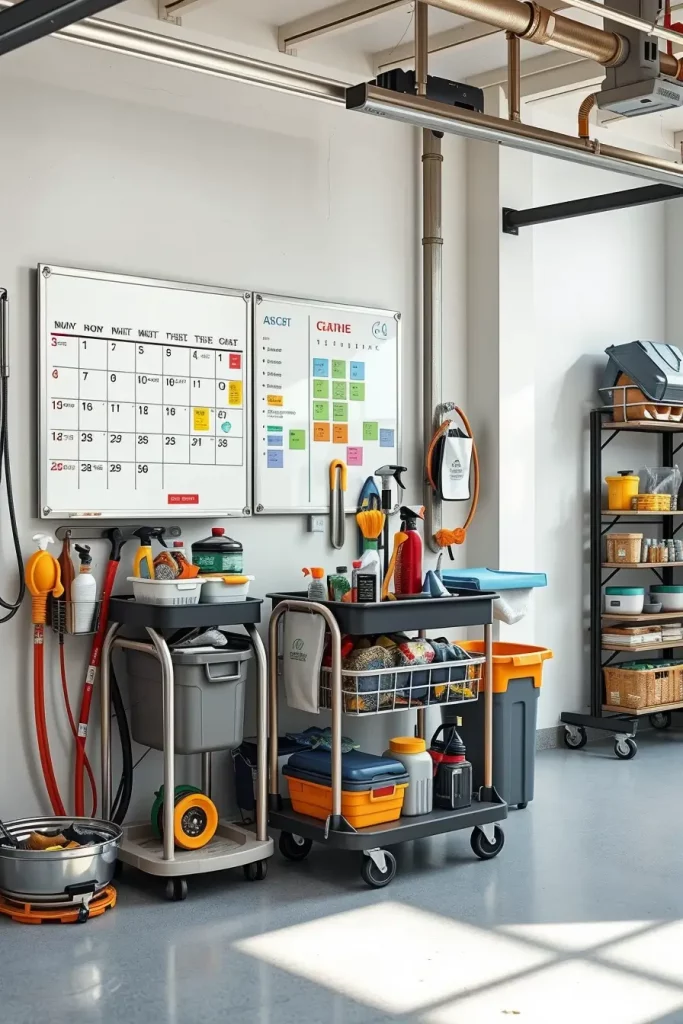
From a practical standpoint, I put up a dry-erase board or a laminated calendar right next to the entrance. Each month has its specific tasks which are color-coded and listed, be it checking chemical supplies, dusting the shelf, or replacing the air filters. Additionally, I have a rolling cart with basic organizational and cleaning supplies, so I am always ready to jump in.
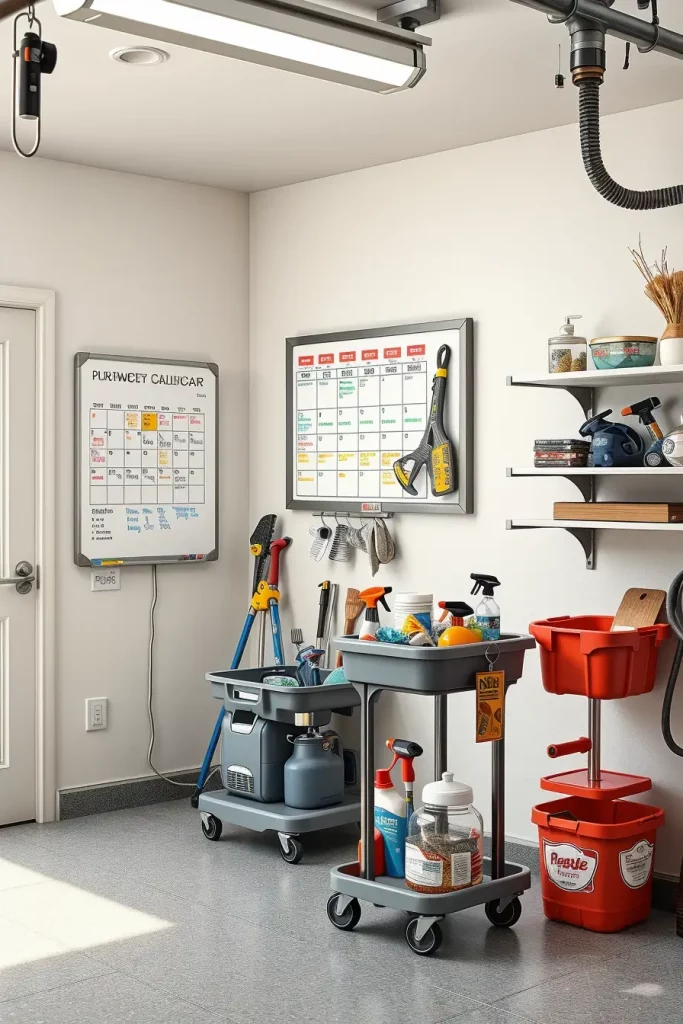
This method helped decrease my stress and time. For example, I used to spend entire weekends cleaning a cluttered garage, but because I’ve adopted this method, I no longer need to tackle that herculean task. Many HGTV experts emphasize the need for home organization maintenance at set intervals—and I’ve found that true for my garage as well.
For this section, I’d suggest adding a reminder feature—like digital reminders tied to calendars or smart home devices. This adds another layer of busy month management so things don’t slip through the cracks.
You don’t need to have a complete makeover to change the look of your garage. All you need is the right approach along with some brilliant garage organization tips. With practical solutions including ceiling racks, labeled bins, and rolling workbenches, you can free up space and optimize efficiency. I would love to hear what kinds of personalized organization techniques you used for your garage or which suggestions you plan on trying; so feel free to comment below.
